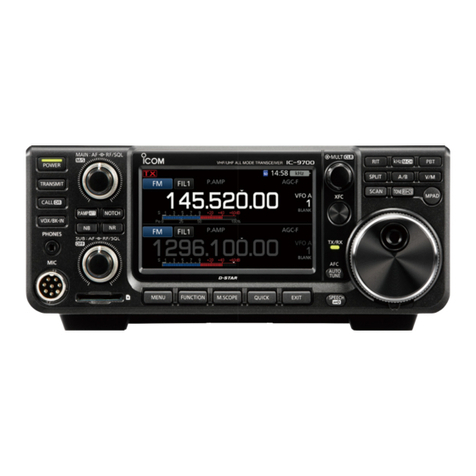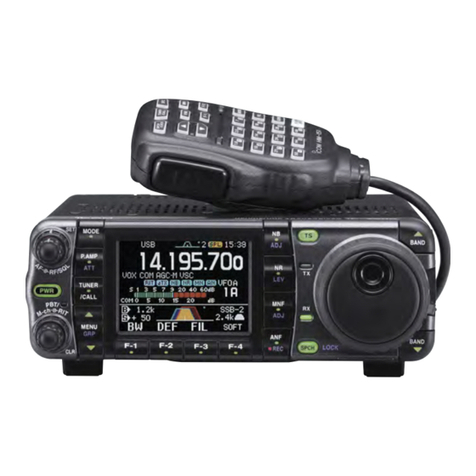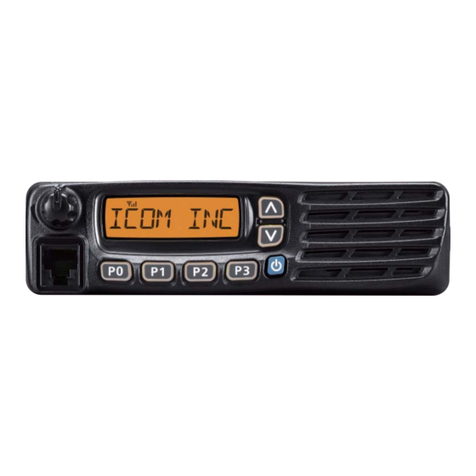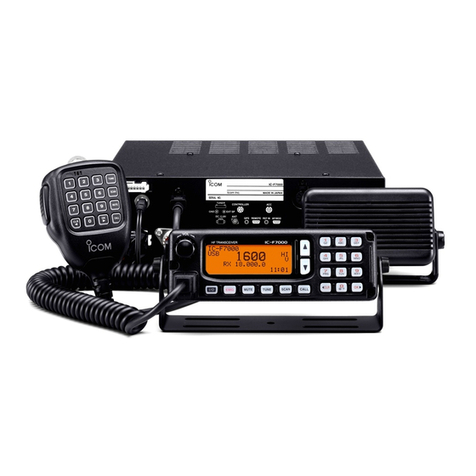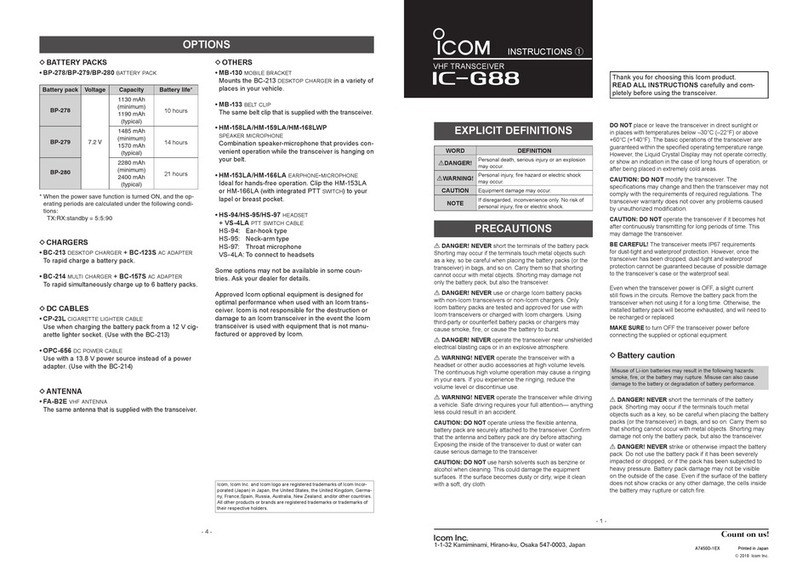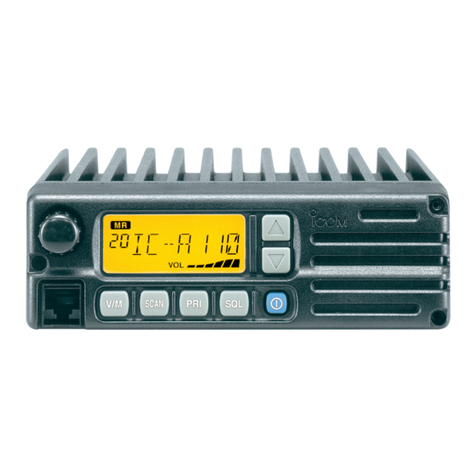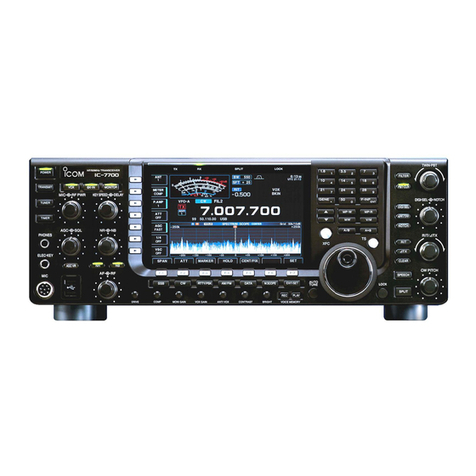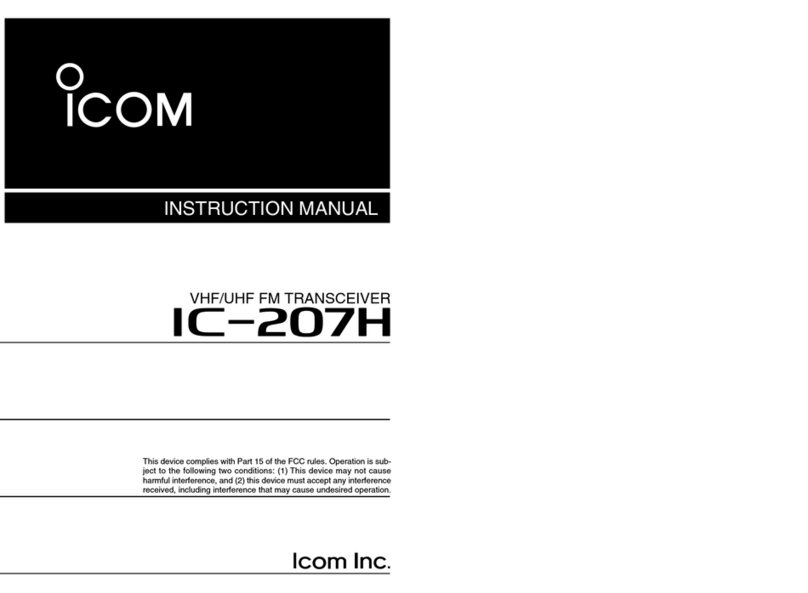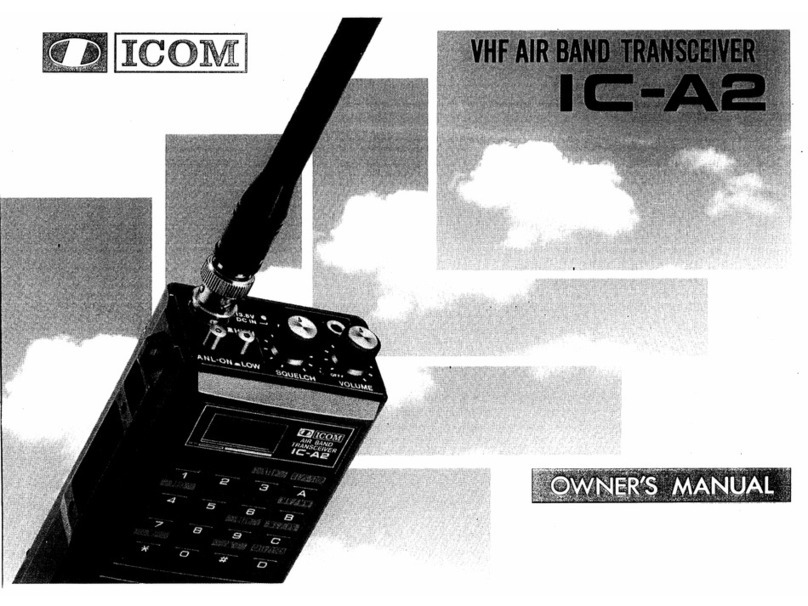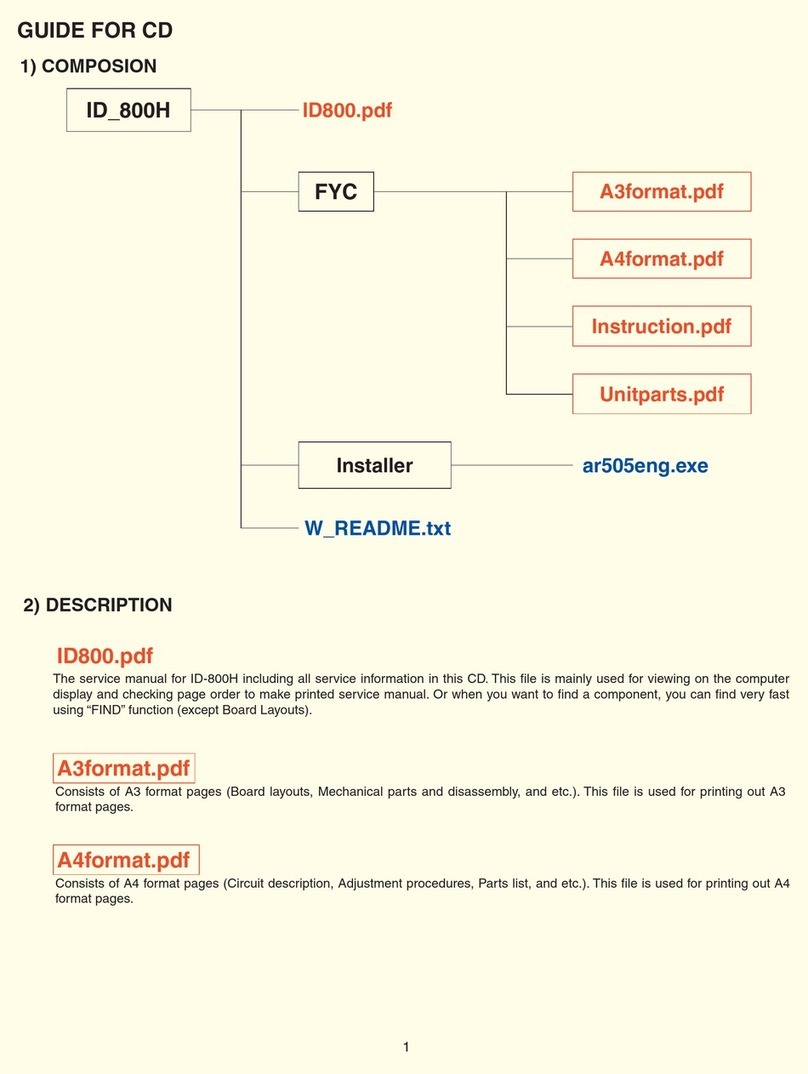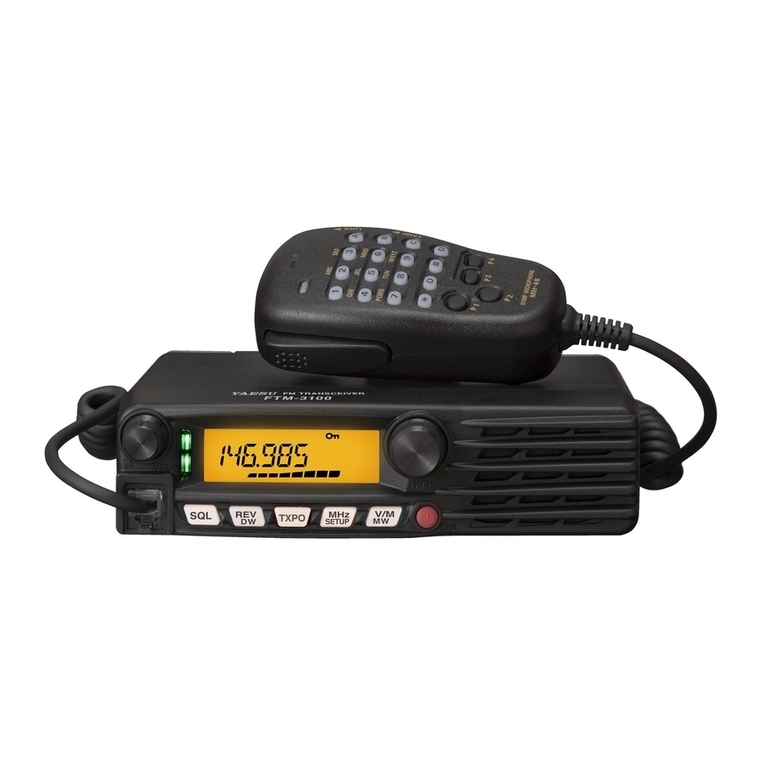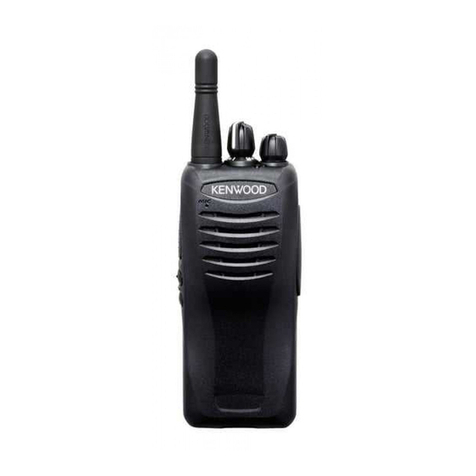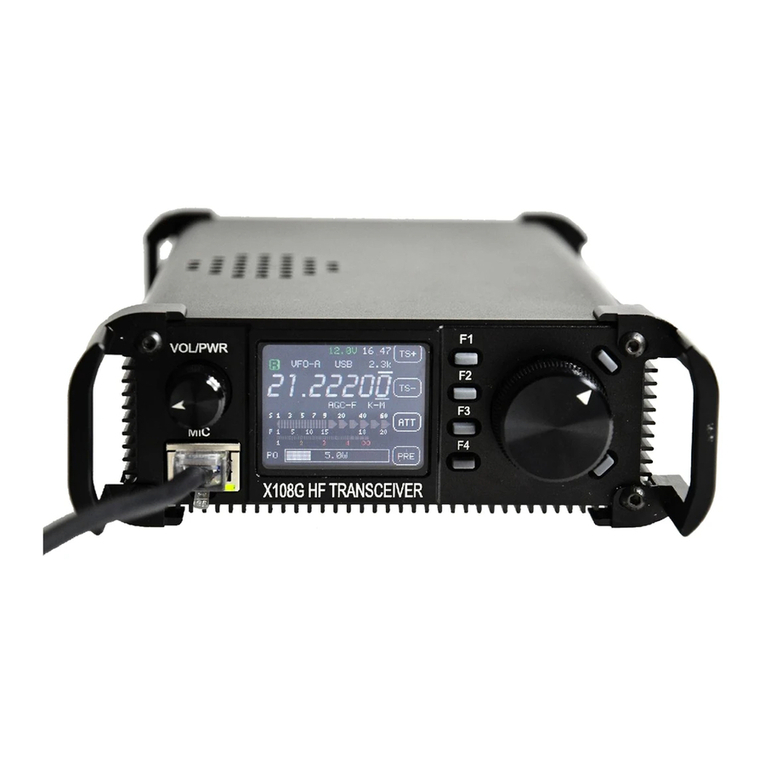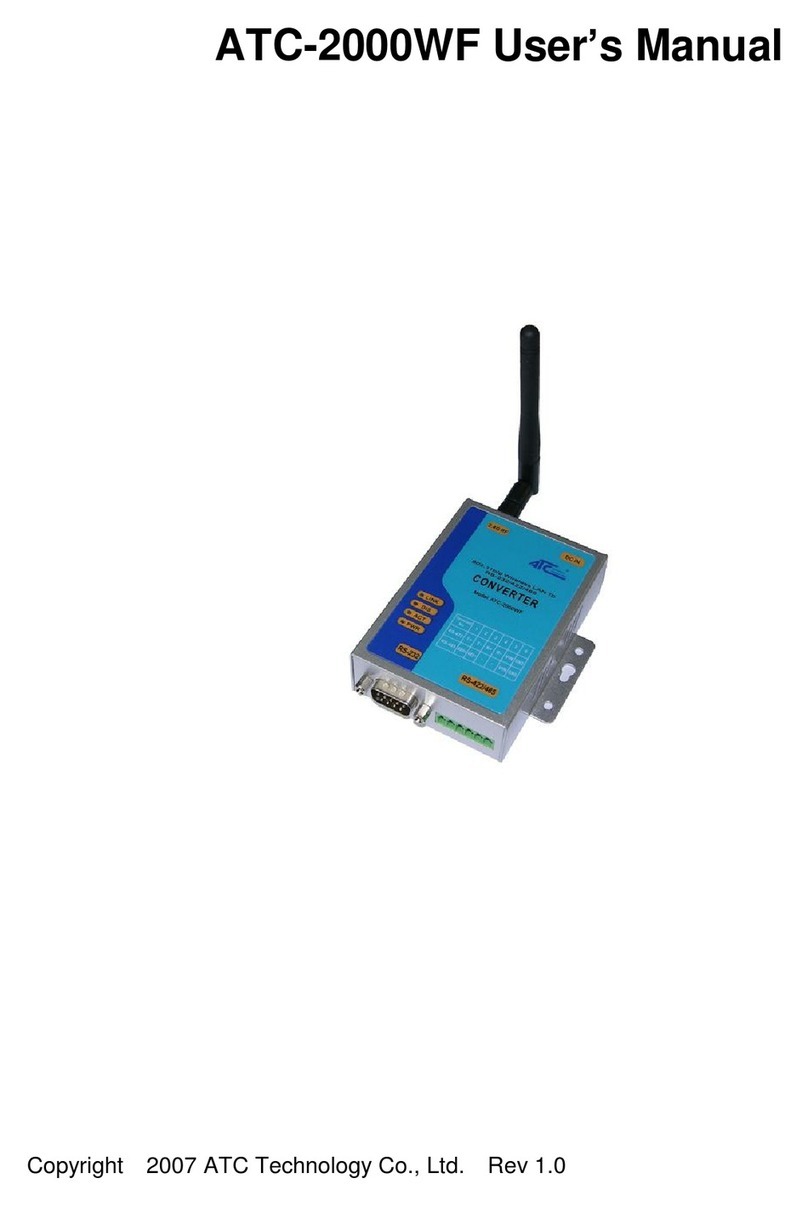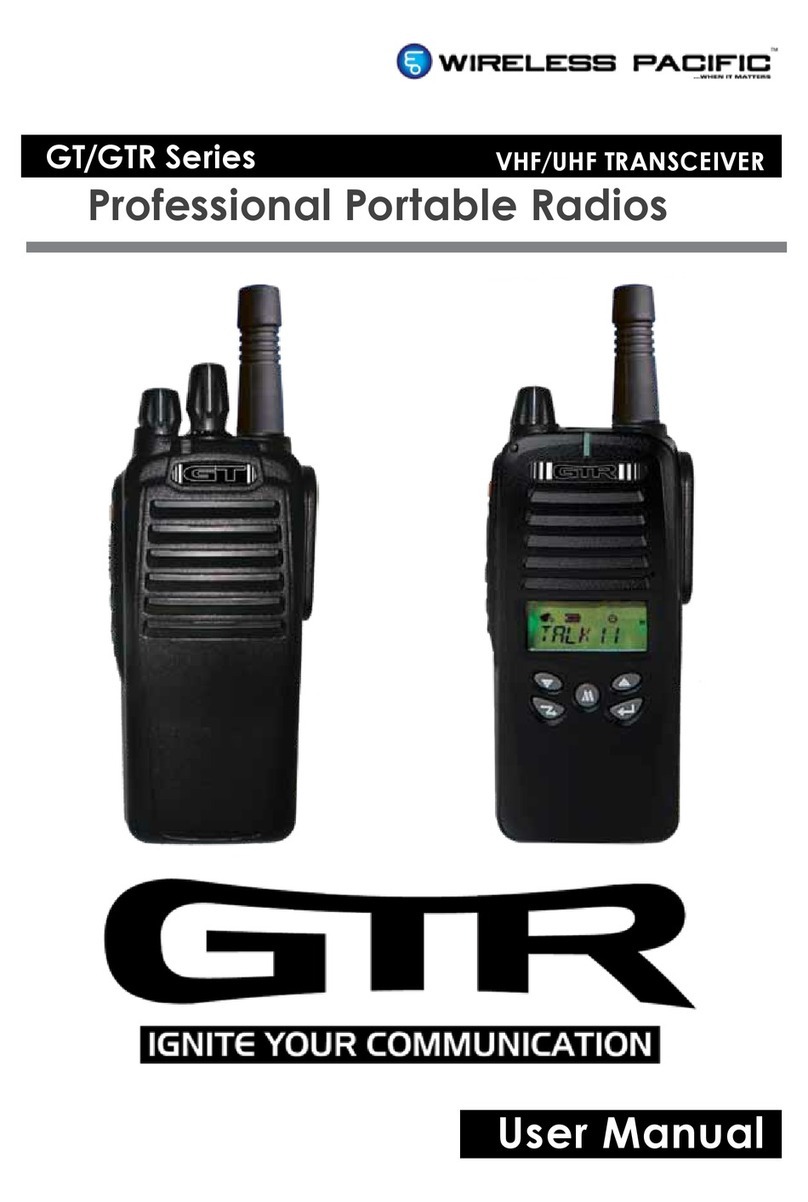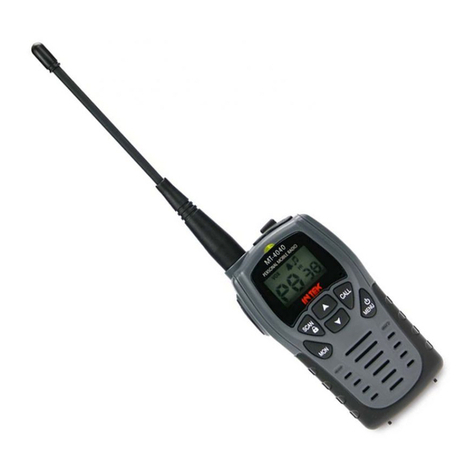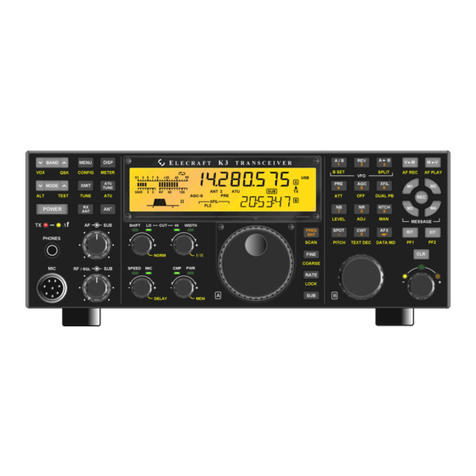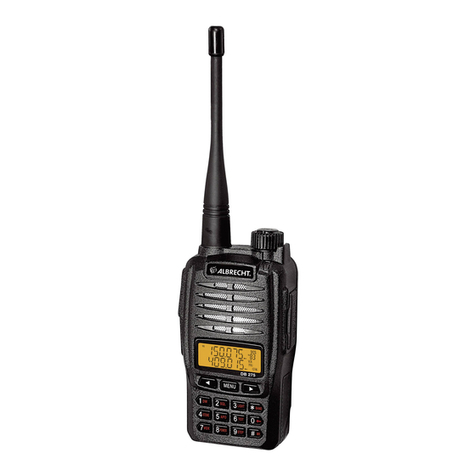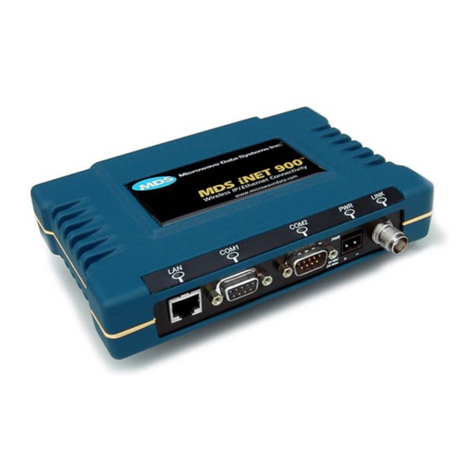Icom IC-756PROIII User manual

HF/50MHz ALL MODE TRANSCEIVER
SERVICE
MANUAL

U.S.A.
Europe
France
United Kingdom
Italy
Korea
Spain
#32
#33
#34
#35
#38
#39
#40
USA
EUR
FRA
UK
ITA
KOR
ESP
INTRODUCTION
This service manual describes the latest service information
for the IC-756PROIII HF/50MHz ALL MODE TRANSCEIV-
ER.
DANGER
NEVER connect the transceiver to an AC outlet or to a DC
power supply that uses more than 16 V. This will ruin the
transceiver.
DO NOT expose the transceiver to rain, snow or any liquids.
DO NOT reverse the polarities of the power supply when con-
necting the transceiver.
DO NOT apply an RF signal of more than 20 dBm (100 mW)
to the antenna connector. This could damage the transceiv-
er’s front end.
ORDERING PARTS
Be sure to include the following four points when ordering
replacement parts:
1. 10-digit order numbers
2. Component part number and name
3. Equipment model name and unit name
4. Quantity required
<SAMPLE ORDER>
1110000960 S.IC NJM4558M IC-756PROIII MAIN-A UNIT 5 pieces
8810005770 Screw BiH M3×8 ZK IC-756PROIII Top cover 10 pieces
Addresses are provided on the inside back cover for your
convenience.
REPAIR NOTES
1. Make sure a problem is internal before disassembling the
transceiver.
2. DO NOT open the transceiver until the transceiver is
disconnected from its power source.
3. DO NOT force any of the variable components. Turn
them slowly and smoothly.
4. DO NOT short any circuits or electronic parts. An insu-
lated tuning tool MUST be used for all adjustments.
5. DO NOT keep power ON for a long time when the trans-
ceiver is defective.
6. DO NOT transmit power into a signal generator or a
sweep generator.
7. ALWAYS connect a 50 dB to 60 dB attenuator between
the transceiver and a deviation meter or spectrum ana-
lyzer when using such test equipment.
8. READ the instructions of test equipment thoroughly
before connecting equipment to the transceiver.
To upgrade quality, any electrical or mechanical parts and
internal circuits are subject to change without notice or
obligation.
Icom, Icom Inc. and are registered trademarks of Icom Incorporated (Japan) in the United States, the United Kingdom,
Germany, France, Spain, Russia and/or other countries.
VER.NO. SYMBOL VERSION

TABLE OF CONTENTS
SECTION 1 SPECIFICATIONS
SECTION 2 INSIDE VIEWS
SECTION 3 CIRCUIT DESCRIPTION
SECTION 4 ADJUSTMENT PROCEDURES
SECTION 5 PARTS LIST
SECTION 6 MECHANICAL PARTS AND DISASSEMBLY
SECTION 7 SEMI-CONDUCTOR INFORMATION
SECTION 8 BOARD LAYOUTS
8 - 1 DISPLAY BOARD . . . . . . . . . . . . . . . . . . . . . . . . . . . . . . . . . . . . . . . . . . . . . . . . . . . . . . . . . . . . . . . .8 - 1
8 - 2 MODE BOARD . . . . . . . . . . . . . . . . . . . . . . . . . . . . . . . . . . . . . . . . . . . . . . . . . . . . . . . . . . . . . . . . . .8 - 3
8 - 3 PHONE BOARD . . . . . . . . . . . . . . . . . . . . . . . . . . . . . . . . . . . . . . . . . . . . . . . . . . . . . . . . . . . . . . . . .8 - 3
8 - 4 KEY BOARD . . . . . . . . . . . . . . . . . . . . . . . . . . . . . . . . . . . . . . . . . . . . . . . . . . . . . . . . . . . . . . . . . . .8 - 3
8 - 5 TEN-KEY BOARD . . . . . . . . . . . . . . . . . . . . . . . . . . . . . . . . . . . . . . . . . . . . . . . . . . . . . . . . . . . . . . .8 - 3
8 - 6 PBT BOARD . . . . . . . . . . . . . . . . . . . . . . . . . . . . . . . . . . . . . . . . . . . . . . . . . . . . . . . . . . . . . . . . . . . .8 - 5
8 - 7 RIT BOARD . . . . . . . . . . . . . . . . . . . . . . . . . . . . . . . . . . . . . . . . . . . . . . . . . . . . . . . . . . . . . . . . . . . .8 - 5
8 - 8 MIC BOARD . . . . . . . . . . . . . . . . . . . . . . . . . . . . . . . . . . . . . . . . . . . . . . . . . . . . . . . . . . . . . . . . . . . .8 - 5
8 - 9 MEMORY BOARD . . . . . . . . . . . . . . . . . . . . . . . . . . . . . . . . . . . . . . . . . . . . . . . . . . . . . . . . . . . . . . .8 - 5
8 - 10 MAIN-A UNIT . . . . . . . . . . . . . . . . . . . . . . . . . . . . . . . . . . . . . . . . . . . . . . . . . . . . . . . . . . . . . . . . . . .8 - 7
8 - 11 DSP-A BOARD . . . . . . . . . . . . . . . . . . . . . . . . . . . . . . . . . . . . . . . . . . . . . . . . . . . . . . . . . . . . . . . . . .8 - 9
8 - 12 RF-B UNIT . . . . . . . . . . . . . . . . . . . . . . . . . . . . . . . . . . . . . . . . . . . . . . . . . . . . . . . . . . . . . . . . . . . .8 - 11
8 - 13 BPF-A BOARD . . . . . . . . . . . . . . . . . . . . . . . . . . . . . . . . . . . . . . . . . . . . . . . . . . . . . . . . . . . . . . . . .8 - 13
8 - 14 PREAMP BOARD . . . . . . . . . . . . . . . . . . . . . . . . . . . . . . . . . . . . . . . . . . . . . . . . . . . . . . . . . . . . . . .8 - 13
8 - 15 PLL UNIT . . . . . . . . . . . . . . . . . . . . . . . . . . . . . . . . . . . . . . . . . . . . . . . . . . . . . . . . . . . . . . . . . . . . .8 - 15
8 - 16 PA UNIT . . . . . . . . . . . . . . . . . . . . . . . . . . . . . . . . . . . . . . . . . . . . . . . . . . . . . . . . . . . . . . . . . . . . . .8 - 17
8 - 17 FILTER-A UNIT . . . . . . . . . . . . . . . . . . . . . . . . . . . . . . . . . . . . . . . . . . . . . . . . . . . . . . . . . . . . . . . . .8 - 19
8 - 18 CTRL-A UNIT . . . . . . . . . . . . . . . . . . . . . . . . . . . . . . . . . . . . . . . . . . . . . . . . . . . . . . . . . . . . . . . . . .8 - 21
8 - 19 TUNER-A BOARD . . . . . . . . . . . . . . . . . . . . . . . . . . . . . . . . . . . . . . . . . . . . . . . . . . . . . . . . . . . . . .8- 23
SECTION 9 BLOCK DIAGRAM
SECTION 10 VOLTAGE DIAGRAMS
10 - 1 FRONT UNIT . . . . . . . . . . . . . . . . . . . . . . . . . . . . . . . . . . . . . . . . . . . . . . . . . . . . . . . . . . . . . . . . . . 10 - 1
10 - 2 DSP-A BOARD . . . . . . . . . . . . . . . . . . . . . . . . . . . . . . . . . . . . . . . . . . . . . . . . . . . . . . . . . . . . . . . . 10 - 3
10 - 3 TUNER-A, MEMORY BOARDS AND CTRL-A UNIT . . . . . . . . . . . . . . . . . . . . . . . . . . . . . . . . . . . . . 10 - 5
10 - 4 MAIN-A UNIT . . . . . . . . . . . . . . . . . . . . . . . . . . . . . . . . . . . . . . . . . . . . . . . . . . . . . . . . . . . . . . . . . 10 - 7
10 - 5 PLL UNIT . . . . . . . . . . . . . . . . . . . . . . . . . . . . . . . . . . . . . . . . . . . . . . . . . . . . . . . . . . . . . . . . . . . 10 - 12
10 - 6 PA AND FILTER-A UNITS . . . . . . . . . . . . . . . . . . . . . . . . . . . . . . . . . . . . . . . . . . . . . . . . . . . . . . . 10 - 15
10 - 7 BPF-A, PREAMP BOARDS AND RF-B UNIT . . . . . . . . . . . . . . . . . . . . . . . . . . . . . . . . . . . . . . . . . 10 - 17

SECTION 1 SPECIFICATIONS
1 - 1
■GENERAL
• Frequency coverage:
Receive 0.030–60.000 MHz*1, *2
Transmit 1.800–1.999 MHz*23.500–3.999 MHz*2
5.3305, 5.3465, 5.3665, 5.3715, 5.4035 MHz*3
7.000–7.300 MHz*210.100–10.150 MHz*2
14.000–14.350 MHz*218.068–18.168 MHz*2
21.000–21.450 MHz*224.890–24.990 MHz*2
28.000–29.700 MHz*250.000–54.000 MHz*2
*
1Some frequency bands are not guaranteed.
*
2Depending on version.
*
3[USA] only.
• Mode : USB, LSB, CW, RTTY, AM, FM
• Number of memory channels :
101 (99 regular, 2 scan edges)
• Antenna connector : SO-239 ×2 (50 Ω)
phono jack (RCA; 50 Ω)
• Usable temp. range : –10˚C to +50˚C (14˚F to 122˚F)
• Frequency stability : Less than ±0.5 ppm from 1 min. after
power ON.
(–10˚C to +50˚C; 14˚F to 122˚F)
• Freq. resolution : 1 Hz
• Power supply requirement:
13.8 V DC ±15% (negative ground)
• Current drain :
Transmit max. power 23 A
Receive stand-by 3.0 A (typical)
max. audio 3.3 A (typical)
• Dimensions : 340(W)×111(H)×285(D) mm
(proj. not included) ;33⁄8(W)×43⁄8(H)×117⁄32(D) in
• Weight (approx.) : 9.6 kg (21 lb 3 oz)
• ACC 1 connector : 8-pin DIN connector
• ACC 2 connector : 7-pin DIN connector
• CI-V connector : 2-conductor 3.5(d) mm (1⁄8")
• Display : 5-inch (diagonal) TFT color LCD
■TRANSMITTER
• Output power :
SSB/CW/RTTY/FM 5–100 W
AM 5–40 W
• Modulation system :
SSB PSN modulation
AM Low power modulation
FM Phase modulation
• Spurious emission : Less than –50 dB (HF bands)
Less than –60 dB (50 MHz band)
• Carrier suppression: More than 40 dB
• Unwanted sideband suppression:
More than 55 dB
• TX variable range : ±9.999 kHz
• Mic. connector : 8-pin connector (600 Ω)
• ELE-KEY connector: 3-conductor 6.35(d) mm (1⁄4")
• KEY connector : 3-conductor 6.35(d) mm (1⁄4")
• SEND connector : Phono jack (RCA)
• ALC connector : Phono jack (RCA)
■ RECEIVER
• Receive system : Triple-conversion
superheterodyne system
• Intermediate frequencies:
1st IF 64.455 MHz
2nd IF 455 kHz
3rd IF 36 kHz
• Sensitivity :
SSB, CW, RTTY (at 2.4 kHz bandwidth)
1.8–29.99 MHz*10.16 µV (10 dB S/N)
50.0–54.0 MHz*20.13 µV (10 dB S/N)
AM (at 6.0 kHz bandwidth)
0.5–1.799 MHz 13 µV (10 dB S/N)
1.8–29.99 MHz*12.0 µV (10 dB S/N)
50.0–54.0 MHz*21.0 µV (10 dB S/N)
FM (at 15 kHz bandwidth)
28.0–29.99 MHz*10.5 µV (12 dB SINAD)
50.0–54.0 MHz*20.32 µV (12 dB SINAD)
*
1Pre-amp 1 ON *2Pre-amp 2 ON
• Squelch sensitivity : (Pre-amp OFF)
SSB/CW/RTTY Less than 5.6 µV
FM Less than 1.0 µV
• Selectivity :
SSB/RTTY (at 2.4 kHz bandwidth)
More than 2.4 kHz/–6 dB
Less than 3.6 kHz/–60 dB
CW (at 500 Hz bandwidth)
More than 500 Hz/–6 dB
Less than 700 Hz/–60 dB
AM (at 6 kHz bandwidth)
More than 6.0 kHz/–6 dB
Less than 15.0 kHz/–60 dB
FM (at 15 kHz bandwidth)
More than 12 kHz/–6 dB
Less than 20 kHz/–60 dB
• Spurious and image rejection ratio:
More than 70 dB
(except IF through in 50 MHz band)
• RIT variable range : ±9.999 kHz
• Audio output power : More than 2.0 W at 10% distortion
(at 13.8 V DC) with an 8 Ωload
• PHONES connector: 3-conductor 6.35(d) mm (1⁄4")
• EXT SP connector : 2-conductor 3.5(d) mm (1⁄8") 8 Ω
■ANTENNA TUNER
• Matching impedance range:
HF bands 16.7 to 150 Ωunbalanced*1
50 MHz band 20 to 125 Ωunbalanced*2
*
1Less than VSWR 3:1 *2Less than VSWR 2.5:1
• Minimum operating input power:
8 W
• Tuning accuracy : VSWR 1.5:1 or less
• Insertion loss : Less than 1.0 dB
(after tuning)
All stated specifications are subject to change without notice or obligation.

SECTION 2 INSIDE VIEWS
2 - 1
• TOP VIEW
Fan control circuit
PA unit
Fan
FILTER-A unit
TUNER-A unit
Antenna tuner CPU
(IC5: M38022M2-138FP)
Drive amplifier
Voltage regulator
Common filter
(L501: LR-386)
Common filter
(L502: LR-386)
CTRL-A unit
Current transformer
(L1: LR-364)
C-MOS IC
(IC14:TC74AC04F)
Fan control circuit
Q10, Q11: 2SC4081×2
Q12, Q13: 2SB1201×2
PA unit
Cooling fan
FILTER-A unit
TUNER-A unit
Antenna tuner CPU
(IC5: M38022M2-138FP)
Drive amplifier circuit
(Q2, Q3: 2SC1972×2)
Voltage regulator
IC1:TA7805F
IC2:TA7805S
IC3:TA78T08C
Common filter
(L501: LR-386)
Common filter
(L502: LR-386)
CTRL-A unit
Current transformer
(L1: LR-364)
C-MOS IC
(IC14:TC74AC04F)
Power amplifier
(Q4, Q5: 2SC5125×2)
Power amplifiers
(Q4, Q5: 2SC5125×2)

2 - 2
• BOTTOM VIEW
Reference frequency oscillator
(X52: CR-338 32.00056MHz)
RF-B unit
BPF-A board
PLL unit
1LO PLL IC
(IC381, IC681: LMX2306TM)
VCO-B circuit
VCO-A circuit
S2LO PLL IC
(IC901: LC7153M)
1LO DDS IC
(IC101, IC401: SC-1246A)
3LO/S3LO DDS IC
(IC701, IC801: SC-1287)
MAIN-A unit
Noise blanker circuit
LCD contorller
(IC3551: S1D13504F00A000)
MAIN CPU
(IC3501: HD64F2375F20)
TX 3rd mixer
(IC221: NJM1496V)
RX 3rd mixer
(IC151:TC4W53FU)
DSP-A board
PREAMP board
TX 1st mixer
(D1451: HSB88WS)
FM IF IC
(IC2001:TA3116FN)
RX 1st mixer circuit
RX 2nd mixer
(D1752: HSB88WS)
TX 2nd mixer
(D1852: HSB88WS)
Reference frequency oscillator
(X52: CR-338. 32.00056MHz)
RF-B unit
BPF-A board
PLL unit
1LO PLL IC
(IC381, IC681: LMX2306TM)
VCO-B circuit
VCO-A circuit
S2LO PLL IC
(IC901: LC7153M)
1LO DDS IC
(IC101, IC401: SC-1246A)
3LO/S3LO DDS IC
(IC701, IC801: SC-1287)
MAIN-A unit
Noise blanker circuit
LCD contorller
(IC3551: S1D13504F00A000)
MAIN CPU
(IC3501: HD64F2375F20)
TX 3rd mixer
(IC221: NJM1496V)
RX 3rd mixer
(IC151:TC4W53FU)
DSP-A board
PREAMP board
TX 1st mixer
(D1451: HSB88WS)
FM IF IC
(IC2001:TA3116FN)
RX 1st mixer circuit
RX 2nd mixer
(D1752: HSB88WS)
TX 2nd mixer
(D1852: HSB88WS)

SECTION 3 CIRCUIT DESCRIPTION
3 - 1
•
Receiver construction
1st LO B
1st LO A
LPF or
BPF
2nd LO
64.0 MHz
Crystal
filter
FI1701
1st mixer A
Q1203–Q1206
1st mixer B
Q1003–Q1006
2nd mixer
D1752
3rd LO
491 kHz
3rd mixer
IC151
64.455 MHz
0.03–60.0 MHz
Ceramic
filter
FI111
455 kHz
to squelch gate
(IC301)
36 kHz DSP-A
board
RF-B UNIT MAIN-A UNIT
Band Control
signal
Input
diode Band Control
signal
Input
diode
0.03–1.6 MHz B0 D801 11–15 MHz B7 D551
1.6–2 MHz B1 *D3201 15–22 MHz B8 D602
2–3 MHz B2 *D3301 22–30 MHz B9 D651
3–4 MHz B3 *D3401 30–50 MHz B10W D701
4–6 MHz B4 *D3501 50–54 MHz B10 D751
6–8 MHz B5 *D3601 54–60 MHz B10W D701
8–11 MHz B6 D501
3-1 RECEIVER CIRCUIT
3-1-1 RF SWITCHING CIRCUIT
(CTRL-A AND RF-B UNITS)
The RF switching circuit leads receive signals to bandpass
filters from an antenna connector while receiving. However,
the circuit leads the signal from the RF power amplifier to
the antenna connector while transmitting.
RF signals from [ANT 1] or [ANT 2] pass through the an-
tenna selector (RL3), transmit/receive switching relays (RL1,
RL2, RL4), and low-pass filter (L27, L28, C63–C66, C105),
and are then applied to the RF-B unit via J101 (RF-B unit).
The signals from the CTRL-A unit either bypass or pass
through the 6 dB (RF-B unit, R102, R106, R111, RL102)
and/or 12 dB (RF-B unit, R112, R113, R114, RL103)
attenuators via the antenna selector (RL101). By selecting
the attenuators, 0 (bypass), 6, 12 and 18 dB attenuations
are obtained. The signals are then applied to the RF filters.
When the [RX ANT] is selected, the RF signals are passed
through the low-pass filter (RF-B unit, L101, L102, C101
–C105), then applied to the antenna selector (RF-B unit,
RL101).
3-1-2 RF BANDPASS FILTER CIRCUIT
(RF-B UNIT AND BPF-A BOARD)
RF bandpass filters pass only the desired band signals and
suppress any undesired band signals. The RF circuit has 11
bandpass filters and 1 low-pass filter.
(1) 0.03–1.6 MHz (RF-B UNIT)
The signals pass through the low-pass filter (L801–L802,
C802, C805–C807), attenuator (R801–R803), and are then
applied to the RF amplifiers (Q1001, Q1002).
(2) 1.6–60 MHz (RF-B UNIT AND BPF-A BOARD)
The signals pass through the band switch (D104) and high-
pass filter (L251–L253, C251, C252, C271–C274) to sup-
press excessively strong signals below 1.6 MHz. The filtered
signals are applied to one of 11 bandpass filters on the table
at right above, and then applied to or bypassed the pre-
amplifier circuit.
3-1-3 PRE-AMPLIFIER CIRCUITS (PRIAMP BOARD)
The IC-756PROIII has 2 gain levels of pre-amplifier circuits.
One has 10 dB gain for the 1.8–21 MHz bands and the other
one has 16 dB gain for the upper 24 MHz bands.
When the [P.AMP] switch is set to [P.AMP 1] or [P.AMP
2], the signals are applied to the pre-amplifier 1 (Q4201,
Q4202) or pre-amplifier 2 (Q4302) circuit, respectively. Pre-
amplified or bypassed signals are applied to the RF amplifier
circuits (RF-B unit; Q1001, Q1002 or Q1201, Q1202).
3-1-4 RF AMPLIFIER AND 1ST MIXER CIRCUITS
(RF-B UNIT)
The 1st mixer circuit mixes the receive signals with the 1st
LO signal to convert the receive signal frequencies into a
64.455 MHz 1st IF signal. The IC-756PROIII has two 1st
mixer circuits for the dualwatch function.
The signals from the pre-amplifier circuit, or signals which
bypass the pre-amplifiers, are divided at L902, L903. Each
signal is applied to a 60 MHz cut-off low-pass filter, RF am-
plifier (Q1001, Q1002 for sub readout or Q1201, Q1202 for
main readout) and then to a 1st mixer (Q1003–Q1006 sub
readout or Q1203–Q1206 for main readout) to convert the
frequency into the 64.455 MHz 1st IF signal.
Each 1st LO signal (64.4850–124.4550 MHz) from the PLL
unit via J1101 or J1301. The LO signals are amplified at the
LO amplifier (Q1101; sub or Q1301; main), filtered by a low-
pass filter, and then applied to each 1st mixer.
*: On the BPF-A board
• Used RF filter

3 - 2
3-1-5 1ST IF CIRCUIT (RF-B UNIT)
The 1st IF circuit filters and amplifies the 1st IF signal. The
1st IF signal combined at L1018 and is then applied to a
MCF (Monolithic Crystal Filter; FI1701) to suppress out-of-
band signals.
The 1st IF signal level is adjusted at the PIN attenuators
(D1001, D1003, D1004; sub or D1201, D1203, D1204 for
main) controlled by the [BAL] controller for the dualwatch
function. The signal is applied to the 1st IF amplifier (Q1008;
sub or Q1208; main) and then combined at L1018.
The combined signal is pass through the MCFs (FI1701)
and is then applied to the 1st IF amplifier (Q1751). The
amplified signal is then applied to the 2nd mixer circuit.
3-1-6 2ND MIXER CIRCUIT (RF-B UNIT)
The 2nd mixer circuit mixes the 1st IF signal and 2nd LO
signal (64.00 MHz) for conversion into the 2nd IF signal.
The 1st IF signal from the 1st IF amplifier (Q1751) is con-
verted into a 455 kHz 2nd IF signal at the 2nd mixer circuit
(D1752).
The 2nd IF signal is applied to the noise blanker gate
(MAIN-A unit) via the J1851.
3-1-7 NOISE BLANKER CIRCUIT (MAIN-A UNIT)
The noise blanker circuit detects pulse-type noise, and
turns OFF the signal line when the noise appears.
The 2nd IF signal from the RF-B unit is applied to the noise
blanker gate (D113, D114).
A portion of the 2nd IF signal is amplified at the noise
amplifiers (Q271–Q273, Q279), and is then detected at the
noise detector (D271) to convert the noise components to
DC voltages.
The signal is then applied to the noise blanker switch (Q276,
Q278). At the moment the detected voltage exceeds Q276’
s threshold level, Q278 outputs a blanking signal to close
the noise blanker gate (D113, D114). The PLL unlock sig-
nal are also applied to Q278, to control the noise blanker
gate.
Some DC voltage from the noise detector circuit is fed back
to the noise amplifiers (Q271, Q272) via the DC amplifiers
(Q274, Q275). The DC amplifiers function as an AGC cir-
cuit to reduce average noise. Therefore, the noise blanker
function shuts off pulse-type noise only.
3-1-8 2ND IF CIRCUIT (MAIN-A UNIT)
The 2nd IF circuit amplifies and filters the 2nd IF signal,
and applies the 2nd IF signal to the 3rd mixer circuit.
The 2nd IF signal from the noise blanker gate (D113,
D114) is amplified at the 2nd IF amplifier (Q141) and
passed through the ceramic filter (FI111). The filtered sig-
nal is applied to the 3rd mixer circuit.
3-1-9 3RD MIXER AND 3RD IF CIRCUITS
(MAIN-A UNIT)
The 3rd mixer circuit mixes the 2nd IF signal and the 3rd
LO signal to obtain the 3rd IF (36 kHz) signal.
The 2nd IF signal from the ceramic filter (FI111) is applied
to the 3rd mixer circuit (IC151, pin 1). The 3rd LO signal
from the PLL unit is applied to the 3rd mixer (IC151, pin 5).
The 3rd IF signal is output from pin 6.
The 3rd IF signal is passed through the low-pass filter
(IC201a) and amplified at the 3rd IF amplifier (IC201b). The
amplified signal is then applied to the DSP-A board via
J201 (pin 27) as DRIF signal.
3-1-10 DSP RECEIVER CIRCUIT (DSP-A BOARD)
The DSP (Digital Signal Processor) circuit enables digital
IF filter, digital noise reduction, digital PSN (Phase Shift
Network)/Low Power/Phase demodulation, digital automatic
notch, and etc.
The 36 kHz 3rd IF signal from the 3rd IF amplifier (MAIN-A
unit, IC201b) is amplified at the differential amplifiers
(IC2301a/b) after being passed through the T/R switch
(IC2291), and is then applied to the A/D converter (IC2321).
Differential
converter
A/D
converter
DRIF
DRAF
• DSP receiver circuit
6
71
IC2291
IC2301b/a IC2321
Level
converter
IC2051
D/A
converter
IC2052
Level
converter
IC2351
DSP IC
IC2001
LPF
IC2401
T/R switch
13
12
14
IC2372x
15
9
1
IC2372y
HPF
IC2441a
Mixer
amplifier
IC2471a
5
3
4
IC2372z
4
7
1
IC2473
MAIN-A unit DSP-A board MAIN-A unit
36 kHz
3rd IF
signal
AF
signals
“TXS” signal
“TXS” signal “TXS” signal
5
11
10

3 - 3
The converted signal is changed from a 5 V level signal to
a 3.3 V signal in the level converter (IC2051), and is then
applied to the DSP IC (IC2001) for 36 kHz digital IF filter,
demodulation, automatic notch and noise reduction, etc.
The output signal from the DSP IC (IC2001) is changed
from a 3.3 V level signal to a 5 V level signal in the level
converter (IC2502), and is applied to the D/A converter
(IC2351) to convert into the analog audio signals.
The converted audio signals are passed through the active
filter (IC2371a), AF amplifier (IC2371b), analog switches
(IC2372, pins 13, 14 and pins 1, 15) then applied to the
low-pass filter (IC2401, pins 5, 11). The filtered signals are
passed through the analog switches (IC2372, pins 3, 4 and
IC2473, pins 1, 7), high-pass filter (IC2441A) and mixer
amplifier (IC2471A), and then applied to the MAIN-A unit
via J2001 (pin 13) as the DRAF signal.
3-1-11 TWIN PBT CIRCUIT (DSP-A BOARD)
General PBT (Passband Tuning) circuit shifts the center fre-
quency of IF signal to electronically narrow the passband
width. The IC-756PROIII uses the DSP circuit for the digital
PBT function and actually shifts the both lower and higher
passbands of 3rd IF filter within ±1.8 kHz.
The twin PBT circuit in DSP IC (IC2001) controlled by the
[TWIN PBT] controller adjusts the 3rd IF passband width
and rejects interference.
3-1-12 AGC CIRCUIT (DSP-A BOARD)
The AGC (Automatic Gain Control) circuit reduces IF ampli-
fier gain and attenuates IF signal to keep the audio output
at a constant level.
The receiver gain is determined by the voltage on the
AGC line (IC2461, pin 4). The D/A converter (IC2461) for
AGC supplies control voltage to the AGC line and sets the
receiver gain with the [RF/SQL] control.
The 3rd IF signal from the level converter (IC2051) is
detected at the AGC detector section in DSP IC (IC2001),
and is applied to the D/A converter for AGC via the level
converter (IC2052). The AGC voltage is amplified at the
buffer amplifier (IC2471b), and is then applied to the
MAIN-A unit via J2001 (pin 16) to control the AGC line.
When receiving strong signals, the AGC voltage decreases
via the buffer amplifier (IC2471b). As the AGC voltage is
used for the bias voltage of the IF amplifier (RF-B unit;
Q1751), and IF amplifier gain is decreased.
3-1-13 S-METER CIRCUIT (MAIN-A UNIT)
The S-meter circuit indicates the relative received signal
strength while receiving by utilizing the AGC voltage which
changes depending on the received signal strength.
A portion of the AGC bias voltage from the DSP-A board
is applied to the differential amplifier (IC101a, pin 2) where
the difference between the AGC and reference voltage is
detected.
The detected voltage is passed through the analog switch
(IC3631, pins 12, 14) as the SML signal and applied to the
main CPU (IC3501, pin 108) to activate the S/RF meter via
the sub CPU (DISPLAY board, IC401).
3-1-14 SQUELCH CIRCUIT (MAIN-A UNIT)
The squelch circuit mutes audio output when the S-meter
signal is lower than the [RF/SQL] setting level.
The S-meter signal is applied to the main CPU (IC3501, pin
108) and is compared with the threshold level set by the
[RF/SQL] control. The [RF/SQL] setting signal is applied to
the main CPU via the sub CPU (DISPLAY board; IC401,
pin 91). The main CPU analyzes the compared signal and
outputs control signal to the squelch gate (IC301, pin 5)
via the interface IC (IC3653, pin 19) to open or close the
squelch as the SQLS signal.
3-1-15 AF AMPLIFIER CIRCUIT (MAIN-A UNIT)
The AF amplifier amplifies the audio signals to a suitable
driving level for the speaker.
The AF signals (DRAF) from the DSP-A board are passed
through the squelch gate (IC301, pins 1, 7) and amplified
at the AF amplifier section of IC311 (pins 2, 4), and volume
is controlled by the AFGV signal at the VCA section (pins 7
–9). The volume controlled AF signals are passed through
the AF mute gate (IC331, pins 1, 7), then applied to the AF
power amplifier (IC332, pins 1, 4).
The amplified audio signals are passed through the SP
mute switch (RL351) and [EXT SP] jack then applied to the
internal speaker when no plug is connected to the jack.
The AF mute gate is controlled by the [AF] control via the
sub and main CPUs.
When headphones are connected, the SP mute signal from
the main CPU (IC3501, pin 56) is applied to the SP mute
switch (RL351) via the BUS driver (IC3654, pins 8, 13) as
the SPS signal.
[PHONES]
[EXT SP]
Int. speaker
IC332
AF
power
amp.
DRAF
• AF amplifier circuit
7
6
129
IC301 IC311
Mute switchSquelch gate
MAIN-A unitDSP-A board
“SQLS” signal
“AFGV” signal
56
7
1
IC331 RL351
“AFMS” signal
“SPS” signal
2
AMP VCA

3 - 4
3-2 TRANSMITTER CIRCUITS
3-2-1 MICROPHONE AMPLIFIER CIRCUIT
(MAIN-A UNIT)
The microphone amplifier circuit amplifies microphone
audio signals to a level needed for the DSP circuit.
Audio signals from the [MIC] connector (MIC board; J1,
pin 1) are amplified at the audio amplifier section in IC451
(pins 21, 22) via the analog switch (IC3002, pins 12, 14),
then applied to the buffer amplifier section (IC451, pin 5)
and VCA section. The gain controlled signals are output
from (IC451, pin 9) and passed through the analog switch
(IC3005, pins 12, 14) and then applied to the DSP circuit
via J201 (pin 15) as the DTAF signal.
The VCA section in IC451 (pin 9) controls microphone
input gain according to the [MIC GAIN] control level using
the MIGV signal coming from the main CPU via the I/O
expander (IC3751, pin 4).
3-2-2 VOX CIRCUIT (MAIN-A UNIT)
The VOX (Voice-Operated Transmission) circuit sets trans-
mitting conditions according to voice input.
A portion of the audio signals from the VCA section (IC451,
pin 9) is applied to the AF amplifier (IC3004b, pins 6, 7),
and then applied to the main CPU (IC3501, pin 106) after
passing through the analog switch (IC362, pins 1, 6) as the
VOXL signal.
The VOGV signal is applied to the VCA section in IC3003
(pin 8) from the main CPU via the I/O expander (IC3751,
pin 9) to adjust VOX actionable sensitivity. This is controlled
by the VOX gain set in the VOX SET mode.
3-2-3 DSP TRANSMITTER CIRCUIT
(DSP-A BOARD)
The microphone audio signals from the MAIN-A unit via the
DTAF line are applied to the analog switch (IC2201, pin 4)
and output from pin 3 or 5 to the each modulation circuits.
(1) When SSB mode
The audio signals from the analog switch (IC2201, pin 5)
are amplified at the limiter amplifier (IC2281b) and applied
to the low-pass filter (IC2281c/d) to limit the transmit
passband width.
The filtered signals are then applied to the differential
amplifiers (IC2301a/b) via the analog switch (IC2201, pins
12, 14) and T/R switch (IC2291, pins 1, 7).
(2) When FM/AM modes
The audio signals from the analog switch (IC2201, pin 3)
are applied to the modulation adjustment pots (R2227:
FM mode, R2229: AM mode) via the limiter amplifier, pre-
emphasis circuit (only FM mode) and splatter filter consist
of IC2211. The level adjusted signals are applied to the dif-
ferential amplifiers (IC2301a/b) after being passed through
the analog switch (IC2201, pins 1, 2, 13–15) and T/R
switch (IC2291 pins 1, 7). The pre-emphasis circuit is can-
celled by Q2201, Q2202, Q2211 on AM mode.
The amplified signals at the differential amplifiers (IC2301a/
b) are applied to the A/D converter (IC2321 pins 4, 5). The
converted signals are changed from 5 V level signals to 3.3
V level signals in the level converter (IC2051).
The converted signals are applied to the DSP IC (IC2001)
and modulated at the DSP IC to produce the 36 kHz trans-
mitter IF signal. The modulated IF signal from the DSP IC
is changed from a 3.3 V signal to a 5 V signal in the level
converter (IC2052), and is applied to the D/A converter
(IC2351) to convert into the analog IF signal.
The converted IF signal is passed through the active fil-
ter (IC2371a), buffer amplifier (IC2371b), analog switch
(IC2372, pins 12, 14) then applied to the low-pass filter
(IC2381c/d). The filtered signal is applied to the MAIN-A
unit via J2001 (pin 29) as the DTIF signal.
When SSB or RTTY mode, a portion of the filtered signal
from the low-pass filter (IC2381c/d) is amplified at the IF
and buffer amplifiers (IC2381a/b) and is applied to the
transmit monitor circuit for the monitor function.
DTAF
• DSP Transmitter circuit
LPF
IC2281c/dIC2281b
IC2211a
LPF
IC2211b
MAIN-A unit DSP-A board
AF
signal
“MODS” signal
4
95
3
IC2201z
Mode switch
Differential
converter
A/D
converter DTIF
6
7
1
IC2291
IC2301a/b
IC2321
Level
converter
IC2051
D/A
converter
IC2052
Level
converter
IC2351
DSP IC
IC2001
LPF
IC2381d/c
T/R switch
13
12
14
IC2372x
MAIN-A unit
36 kHz IF
“TXS” signal
“TXS” signal
5
12
13
14
IC2201x
Mode switch
11
11
Limitter
Limitter
SSB
mode
FM/AM
mode

3 - 5
3-2-4 SPEECH COMPRESSOR CIRCUIT
(DSP-A BOARD)
The speech compressor compresses the transmitter audio
input signals to increase the average output level (average
talk power).
When the speech compressor function is ON, the level
shifted signal from the level converter (IC2051) is applied
to the DSP IC (IC2001) and compressed at the DSP IC to
obtain an average audio level.
At the same time, the compressed signals are modulated
at the DSP IC and applied to the level converter (IC2052).
3-2-5 IF AMPLIFIER AND MIXER CIRCUITS
(MAIN-A AND RF-B UNITS)
The modulated 3rd IF signal from the DSP-A board (DTIF:
36 kHz) is applied to the 3rd mixer circuit (MAIN-A unit;
IC221, pin 1). The applied 3rd IF signal is mixed with the
3rd LO signal from the DDS circuit (PLL unit; IC701) to pro-
duce a 455 kHz 2nd IF signal.
The 2nd IF signal is output from (MAIN-A; IC221, pin 6)
and amplified at the IF amplifier (MAIN-A unit; Q241). The
amplified signal is passed through the ceramic bandpass
filter (MAIN-A unit; FI131: FM/AM modes, FI133: other
modes) for unwanted signals are suppressed. The filtered
2nd IF signal is amplified at IF amplifier (MAIN-A unit;
Q261) and applied to the 2nd mixer circuit on the RF-B unit
via J101 (MAIN-A unit).
The 2nd IF signal is mixed with the 64 MHz 2nd LO signal,
coming from the PLL unit, at the 2nd mixer circuit (RF-B
unit; D1852) to obtain a 64.455 MHz 1st IF signal. The 1st
IF signal is passed through a MCFs (RF-B unit; FI1701)
to cut-off the undesired signals then amplified at the IF
amplifier (RF-B unit; Q1551) via the T/R switch (RF-B unit;
D1551). The amplified 1st IF signal is applied to the 1st IF
mixer circuit (RF-B unit; D1451).
The operating (transmitting) frequency is produced at the
1st IF mixer circuit (RF-B unit; D1451) by mixing the 1st IF
and 1st LO signals. The mixed signal is then applied to the
RF circuit.
3-2-6 RF CIRCUIT (RF-B AND PA UNITS)
The RF circuit amplifies operating (transmitting) frequency
to obtain 100 W of RF output.
The signal from the 1st IF mixer (RF-B unit; D451) is
passed through the low-pass filter (RF-B unit; L1402,
L1403, C1405–C1409) and amplified at the RF amplifier
(RF-B unit; IC1401). The amplified signal is amplified again
at the wide-band YGR amplifier (RF-B unit, IC201) after
passing through one of 10 bandpass (Refer to page 3-1
for bandpass filters used) and high-pass filters, and is then
applied to the PA unit via J201 (RF-B unit).
The signal applied from the RF-B unit is amplified at the
pre-drive (Q1), drive (Q2, Q3) and power amplifiers (Q4,
Q5) in sequence to obtain a stable 100 W of RF output
power. The amplified signal is applied to one of 8 low-pass
filters in the FILTER-A unit.
3-2-7 LOW-PASS FILTER CIRCUIT (FILTER-A UNIT)
The low-pass filter circuit contains 8 Chebyschev low-pass
filters to suppress the higher harmonic components.
The amplified signal from the PA unit is applied to one of
8 low-pass filters, which is selected by the I/O expander
(CTRL-A unit, IC11) via the buffer amplifier (CTRL-A unit;
IC12).
The filtered signal is then applied to one of 2 antenna con-
nectors via the CTRL-A unit.
3-2-8 ALC CIRCUIT (MAIN-A UNIT)
The ALC (Automatic Level Control) circuit controls the gain
of IF amplifiers in order for the transceiver to output a con-
stant RF power set by the [RF POWER] control even when
the supplied voltage shifts, and etc.
The RF power level is detected at one of the APC detector
circuits (CTRL-A unit; D2) to be converted into DC voltage
and applied to the MAIN-A unit as the FORV signal.
The FORV signal from the CTRL-A unit is applied to the
comparator (IC551b, pins 6, 7). The POCV signal, con-
trolled by the [RF POWER] control via the I/O expander
(IC3751, pin 5), is also applied to the other input (IC551b,
pin 5) for reference. The compared signal is output from
pin 7 and applied to the IF amplifiers in the MAIN-A (Q261)
and RF-B (Q1551) units to control amplifying gain.
• Transmitter construction
1st LO
(64.485–
124.455 MHz)
D1451
Ceramic
filter
Crystal
filter
FI1701
LPF BPFs
FI131
Ceramic
filter
FI133
MIC 455 kHz
DSP-A
board
RF-B UNIT PA UNIT
MAIN-A UNIT
AMP VCA
FM/AM
modes
other
modes
3rd LO
(491 kHz)
IC221
64.455 kHz
2nd LO
(64.00 MHz)
D1852
36 kHz IF
IC451 11
11
12
13
14
14
13
12
IC3005x
IC3002
“MOSL” signal
“MISL” signal
DTAF DTIF
PAIN

3 - 6
When the FORV signal exceeds the POCV voltage, ALC
bias voltage from the comparator (IC551b) controls the IF
amplifiers (Q261). This adjusts the output power to a speci-
fied level from the [RF POWER] control until the FORV and
POCV voltages are equalized.
In AM mode, the comparator operates as an averaging ALC
amplifier. Q502 turns ON and the POCV voltage is shifted
for 40 W AM output power (maximum) through R510.
The ALC bias voltage is also applied to the ALC meter
amplifier (IC551a, pins 1, 2) to obtain an ALC meter signal
(ALCL). The amplified signal is passed through the analog
switch (IC 3631, pins 13, 14) and applied to the main CPU
(IC3501, pin 108) to drive the S/RF meter via the sub CPU
(IC401) on the DISPLAY board.
An external ALC input from the [ALC] jack or [ACC] sock-
ets is applied to the buffer amplifier (Q521). External ALC
operation is identical to that of the internal ALC.
The FORV signal is also applied to the power meter ampli-
fier (IC571a, pins 1, 3). The amplified signal is passed
through the analog switch (IC3631, pins 1, 15) as an FORL
signal and applied to the main CPU (IC3501, pin 109) to
drive the S/RF meter when the power meter is selected.
3-2-9 APC CIRCUIT (MAIN-A UNIT)
The APC (Automatic Power Control) circuit protects the
power amplifiers on the PA unit from high SWR and exces-
sive current.
The reflected wave signal appears and increases when the
connected antenna is mismatched to 50 Ω. The APC detec-
tor circuit (CTRL-A unit; D1 and L1) detects the reflected
signal, and applies it to the APC circuit (IC551c, pins 9, 8)
as REFV signal.
When the REFV signal level increases, the APC circuit
decreases the ALC voltage to activate the APC.
For the current APC, the power transistor current is
obtained by detecting the voltages (ICH and ICL) which
appear at both terminals of the current detector (PA unit;
R28). The detected voltages are applied to the differential
amplifier (IC551d, pins 12–14). When the current of transis-
tors is increased, the amplifier controls the ALC line to pre-
vent excessive current flow.
A portion of the REFV signal is applied to the SWR meter
amplifier (IC571b, pins 5, 7). The amplified signal is passed
through the analog switch (IC3631, pins 3, 4) as an REFL
signal and applied to the main CPU (IC3501, pin 110) to
drive the S/RF meter when the SWR meter is selected.
3-2-10 TEMPERATURE PROTECTION CIRCUIT
(PA UNIT)
The cooling fan (CHASSIS; MF1) is activated while trans-
mitting or when the temperature of the power amplifier
exceeds the preset value. The temperature protection cir-
cuit consists of Q10–Q13 and R50.
While transmitting, Q10 and Q12 are turned ON, and pro-
vide a voltage to the cooling fan to rotate at medium speed.
The thermistor (R50) detects the temperature of the final
amplifier (Q5), and activates Q11 and Q13 to accelerate
the cooling fan when the detected temperature exceeds
70˚C (158˚F). The cooling fan rotates at high speed at 80˚C
(176˚F) or more.
The thermistor keeps the cooling fan rotating even while
receiving until the Q5 temperature drops to 60˚C (140˚F) or
below.
3-2-11 MONITOR CIRCUIT
(DSP-A BOARD AND MAIN-A UNIT)
The microphone audio signals can be monitored to check
voice characteristics.
(1) When FM/AM modes (MAIN-A UNIT)
A portion of the microphone audio signals from the VCA
section (IC451; pins 9, 22) are applied to the analog switch
(IC361; pins 1, 7). The selected audio signals are applied to
IC371 (pin 2), and the output signals from pin 9 are applied
to the AF amplifier circuit (IC311, pin 2, 9).
(2) When SSB/RTTY modes
(DSP-A BOARD)
A portion of the transmit IF signal from the low-pass filter
(IC2381c/d) is amplified at the IF (IC2381b) and buffer
(IC2381a) amplifiers, and applied to the digital mixer circuit
(IC2302). The applied signal is mixed with a 36 kHz LO sig-
nal from the D/A converter (IC2342) to demodulate into the
AF signals. The demodulated signals are passed through
the buffer amplifier (IC2381a), low-pass filter (IC2441b/
c) and AF amplifier (IC2441d), and then applied to the
MAIN-A unit via J2001 (pin 19) as the DMAF signal.
The DMAF signal from the DSP-A board is amplified at the
ALC amplifier (MAIN-A unit; IC372, pins 1, 13) and applied
to the VCA section of IC371 (MAIN-A unit; pins 7, 9). The
volume controlled AF signals is applied to the AF amplifier
circuit (MAIN-A unit; IC311, pins 2, 9).
3-3 PLL CIRCUITS
3-3-1 GENERAL
The PLL unit generates a pair of 1st LO frequencies (64.485
–124.455 MHz) for dualwatch and spectrum scope func-
tions; a 2nd LO frequency (64 MHz), 3rd LO frequency
(491 kHz) and sweep LO frequency for the spectrum scope
function.
The 1st LO PLLs adopt a mixer-less dual loop PLL sys-
tem and has 4 VCO circuits. The LOs, except the 2nd, use
DDSs while the 2nd LO uses the fixed frequency of the
crystal oscillator.
3-3-2 1ST LO PLL CIRCUIT
The 1st LO PLLs contain a main and reference loop as a
dual loop system. Both PLLs have equivalent circuits— this
manual describes only the 1st LO PLL A circuit.
The reference loop generates a 10.747 to 10.865 MHz fre-
quency using a DDS circuit, and the main loop generates a
64.485 to 124.455 MHz frequency using the reference loop
frequency.

3 - 7
(1) REFERENCE LOOP PLL
The oscillated signal at the reference VCO (Q151, D151) is
amplified at the buffer amplifiers (Q102, Q152) and is then
applied to the DDS IC (IC101, pin 46). The signal is then
divided and detected on phase with the DDS generated
frequency.
The detected signal output from the DDS IC (IC101, pin
56) is converted into DC voltage (lock voltage) at the loop
filter (R135–R137, C121, C151) and then fed back to the
reference VCO circuit (Q151, D151).
(2) MAIN LOOP PLL
The oscillated signal at one of the main loop VCOs (Q201,
D201, D202), (Q221, D221, D222), (Q251, D251–D254)
and (Q271, D271–D274) is amplified at the buffer amplifi-
ers (Q301, IC320) and is then applied to the PLL IC (IC381,
pin 6) via the low-pass filter (L303, C304–C307). The signal
is then divided and detected on phase with the reference
loop output frequency.
The detected signal output from the PLL IC (IC381; pin 2)
is converted into a DC voltage (lock voltage) at the loop
filter and then fed back to one of the VCO circuits (Q201,
D201, D202), (Q221, D221, D222), (Q251, D251–D254)
and (Q271, D271–D274).
The oscillated signal is amplified at the buffer amplifiers
(Q301, IC320) and then applied to the RF-B unit as a 1st
LO A signal after being passed through the low-pass filters
(L303, C304–C307 and L351–L353, C351–C356) and high-
pass filter (L354, C358–C360) and mute circuit (D361).
3-3-3 2ND LO AND REFERENCE OSCILLATOR
CIRCUITS
The reference oscillator (X52, Q51) generates a 32.0 MHz
frequency for the 4 DDS circuits as a system clock and
for the LO output. The oscillated signal is doubled at the
doubler circuit (Q71, Q81) and the 64.0 MHz frequency is
picked up at the double tuned filter (L81, L82). The 64.0
MHz signal is applied to the RF-B unit as a 2nd LO signal.
3-3-4 3RD LO CIRCUIT
The DDS IC (IC701) generates a 10-bit digital signal using
the 32 MHz system clock. The digital signal is converted
into an analog wave signal at the D/A converter (R701–
R720). The converted analog wave is passed through the
bandpass filter (L702, L703, C709–C713) and then applied
to the MAIN-A unit as the 3rd LO signal.
3-3-5 MARKER CIRCUIT
The divided signal at the DDS circuit (IC101) is used for
the marker signals with the IC-756PROIII.
The reference signal for the DDS circuit (32.0 MHz) is
divided to produce an acceptable frequency signal, 16
MHz, with the programmable divider then divided again by
160 to obtain 100 kHz cycle square-wave signals.
The generated marker signals are output from pin 66 of the
DDS IC (IC101), and are then applied to the RF-B unit via
the mute switch (IC192) and J851 as the MKR signal.
• PLL CIRCUIT
64.485–
124.455 MHz
0.03–
60.0 MHz
455 kHz
36 kHz
10.747–
10.865 MHz
64.485–
124.455 MHz
64.0 MHz
77.8 MHz
ANT
1st mixer A
Q1203–Q1206
491 kHz
to scope circuit
(RF-B unit, D2101)
to scope circuit
(RF-B unit, IC2001)
IC801IC701
IC101
IC381
IC901
Q71
Q81
Q902
S2LOS3LO
3LO
X2
2LO
1LOB
1LOA
77.8 MHz
RF-B unit
PLL unit
MAIN-A unit
Q201
Q221
Q251
Q271
Q151
1st LO PLL A
circuit
Phase
detector
1/N divider
1/22
Phase
detector
12 bit
D/A
Main loop PLL
Ref. loop PLL
DDS
1st mixer B
1st LO
PLL B
circuit
DDS
D/A
DDS
D/A
PLL
IC
Crystal
filter
2nd mixer
D1752
3rd mixer
IC151
FI1701
64.455 MHz
to DSP-A board
Reference oscillator
X52: 32.0 MHz
BPFBPF
Loop
filter
LPF
LPF

3 - 8
3-4 ANTENNA TUNER CIRCUITS
3-4-1 MATCHING CIRCUIT (TUNER-A UNIT)
The matching circuit is a T-network. Using 2 tuning motors,
the matching circuit obtains rapid overall tuning speed.
Using relays (RL1–RL15), the relay control signals from
the antenna tuner CPU (CTRL-A unit; IC5) via the buffer
amplifier (IC1, IC2) ground one of the taps of L3–L12 and
add capacitors (C34–C43). After selecting the coils and
capacitors, 2 motors (CTRL-A unit; MF1, MF2) adjust C44
and C45 using the antenna tuner CPU (CTRL-A unit; IC5)
and the motor controller (CTRL-A unit; Q211–Q218, D211,
D213, D215, D217) to obtain a low SWR (Standing Wave
Ratio).
3-4-2 DETECTOR CIRCUIT (CTRL-A UNIT)
(1) SWR detector
Forward and reflected power are picked up by a current
transformer (L1), detected by D2 (FOR) and D1 (REF), and
then amplified at IC1a and IC1b, respectively. The amplified
voltages are applied to the antenna tuner CPU (IC5, pins 2,
3). The tuner CPU detects the SWR.
(2) Reactance components detector
Reactance components are picked up by comparing the
phases of the RF current and RF voltage. The RF current is
detected by L4 and R16 and buffer-amplified at IC14e and
IC2a and then applied to the phase comparator (IC3a). RF
voltages are detected by C12–C14 and then applied to the
phase comparator (IC3b) after being amplified at the buffer
amplifiers (IC14c, IC2b). The output signal from the phase
comparator (IC3a, pin 6 for RF current, IC3b pin 7 for RF
voltage) is rectified at D7 and D6 for conversion into DC
voltage. The rectified voltage signals are combined, then
amplified at the inverter amplifier (IC4b), then applied to the
antenna tuner CPU (IC5, pin 64).
A C-MOS IC is used for the buffer amplifier (IC14) to
improve functionable sensitivity; the inverter amplifier
(IC4) is very responsive even with a low signal level input.
Together, these ensure quick and stable signal detection
even at low RF signal level input.
(3) Resistance components detector
Resistance components are picked up by L8, and detected
by D8, D9 and Q5. The detected resistance components
are amplified at the inverter amplifier (IC4a), and then
applied to the antenna tuner CPU (IC5, pin 1).
3-4-3 MOTOR CONTROL CIRCUIT
(CTRL-A AND TUNER-A UNITS)
The control circuit of the internal antenna tuner consists of
the CPU, EEPROM (Electronically-Erasable Programmable
Read Only Memory), tuning motors and tuning relays.
(1) CPU and EEPROM (CTRL-A unit)
The antenna tuner CPU (IC5) controls the tuning motors
via the motor controller (Q211–Q218, D211, D213, D215,
D217) and tuning relays, and memorizes the best preset
position in 100 kHz steps. The memory contents are stored
in the EEPROM (IC6) without a backup battery.
(2) Tuning motors (CTRL-A and TUNER-A units)
A motor controller (Q211–Q218, D211, D213, D215, D217)
rotates the tuning motors (TUNER-A unit; MF1, MF2) to
obtain a low SWR.
(3) Tuning relays (TUNER-A unit)
According to the operating frequency band and antenna
condition, tuning relays select the capacitors and coils.
3-4-4 ANTENNA TUNER CPU PORT ALLOCATION
(CTRL-A unit; IC5)
Pin
number
Port
name
Description
1AN2
Input port for the resistance compo-
nents detection voltage.
2AN1
Input port for the reflected RF pow-
er voltage.
3AN0
Input port for the forward RF power
voltage.
4 PERS
Input port for the transceiver power
OFF.
13 IKEY Outputs transmit control signal to
the main CPU (IC 3501).
15 ISTA Input port for the antenna tuner
start signal.
17 THRU Input port for the [TUNER] ON/OFF
signal from main CPU (IC3501)..
21 TRC Input port for the TX/RX switching
signal.
26 VHF Output the coil select signals for the
tuner unit.
27–32
24M, 18M,
14M, 10M,
7M, 4M
Output the coil select signals to the
tuner unit.
34–40 CO1–CO3,
CI1–CI3
Output the capacitor select signal
to the tuner unit.
41–48
AZ, AY, AX,
AW, PZ, PY,
PX, PW
Output pulse-type control signals
for the tuning motors. (MF1, MF2)
27–32
24M, 18M,
14M, 10M,
7M, 4M
Output the coil select signal to the
tuner unit.
64 AN3 Input port for the reactance compo-
nents detection signal.

3 - 9
3-5 SCOPE CIRCUITS
3-5-1 SCOPE RECEIVER CIRCUIT (RF-B UNIT)
A portion of the 64.455 MHz 1st IF signal from the 1st
mixer circuit (Q1203–Q1206: while receiving) or IF ampli-
fier (Q1551: while transmitting) is passed through the
PIN attenuator (Q2203) and amplified at the IF ampli-
fiers (Q2202, Q2201), and then mixed with the 77.8 MHz
scope 2nd LO (S2LO) signal at the mixer circuit (D2101)
to produce the 13.345 MHz IF signal. The mixed IF signal
is passed through the ceramic bandpass filters (FI2003,
FI2002) to suppress unwanted signals. The filtered IF sig-
nal is applied to the FM IF IC (IC2001, pin 16).
The applied 13.345 MHz IF signal is mixed with the sweep
LO (S3LO) signals from the PLL unit at the FM IF IC
(IC2001). The mixed IF signals are filtered at the ceramic
bandpass filter (FI2001) then applied to the limiter ampli-
fier section in the FM IF IC (IC2001, pin 5). The applied IF
signals are converted into DC voltages according to the
applied IF signal strength at the RSSI section in the IC.
The converted voltages are output from pin12 (IC2001) and
amplified at IC2002, then applied to the MAIN-A unit as the
SCPL signal.
Some of the DC voltages from the FM IF IC (IC2001) are
amplified at IC2002 to produce AGC voltages for the IF
amplifiers (Q2201, Q2202), producing wider dynamic range.
By sweeping LO signals (S3LO) are applied to the mixer
section in the FM IF IC (IC2001), the spectrum scope func-
tion is activated.
3-5-2 SWEEP LO CIRCUIT (PLL UNIT)
The sweep LO signals (S3LO) are generated by the DDS
IC (IC801) using the 32 MHz system clock. A 10-bit digital
signal is converted into analog wave signals at the D/A con-
verter (R801–R820). The converted analog wave is passed
through the bandpass filter (L802, L803, C809–C813) then
applied to the RF-B unit via (J801) after being amplified at
the buffer amplifier (Q802).
3-6 POWER SUPPLY CIRCUITS
3-6-1 PA UNIT
3-6-2 FRONT UNIT
• SCOPE CIRCUIT DIAGRAM
RF-B unit
1st mixer A
Q1203–Q1206
Q2202
to 2nd mixer circuit
to the MAIN-A unit SCPL signal
Q2201
D2101 FI2003 FI2002
Ceramic
BPF
Ceramic
BPF
IF
amp.
IC2002b
AGC
IC2002a
amp.
IF
amp.
Ceramic
BPF
Limiter
amp.
Mixer
IC2001
FI2001
S3LO signal
(12.79–12.99 MHz*)
S2LO signal
(77.80 MHz)
1st LO
signal
16
12
5
3
2
RSSI
*depending on sweeping passband width
RF signals
LINE
PHV
HV
14V
14VA
a8V
5V
H5V
DESCRIPTION
The voltage from an external power supply via
the common filter circuit (FILTER-A unit; L501,
L502).
The same voltage as the PHV line passed
through a fuse (F1).
The same voltage as the HV line passed
through the switching relay (RL1).
The same voltage as the 14 V line is applied to
the AF power amplifier (MAIN-A unit; IC332).
Common 8 V converted from the 14 V line and
regulated by the +8 regulator circuit (IC3).
Common 5 V converted from the 14 V line and
regulated by the +5 regulator circuit (IC2).
Common 5 V converted from the HV line and
regulated by the H5V regulator circuit (IC1).
LINE
5VF
–15V
–7V
–8V
+18V
DESCRIPTION
Common 5 V converted from the 14 V line and
regulated by the +5 regulator circuit (IC861).
Common –15 V converted from the 14 V line
and converted by the –15 DC-DC converter cir-
cuit (IC841, Q841, D841). The voltage is applied
to the –7 V, –8 V regulator circuits and etc.
Common –7 V converted from the –15 V line
and regulated by the –7 regulator circuit (IC501).
Common –8 V converted from the –15 V line
and regulated by the –8V regulator circuit
(IC881).
Common 18 V converted from the 14 V line and
converted by the 18 V DC-DC converter circuit
(IC821, Q821, D822).

3 - 10
3-6-3 MAIN-A UNIT
3-6-4 CTRL-A AND PLL UNITS
3-7 LOGIC CIRCUITS
3-7-2 SUB-CPU PORT ALLOCATIONS
(DISPLAY BOARD; IC401)
LINE
R8V
T8V
DESCRIPTION
Receive 8 V converted from the 14 V line and
regulated by the R8V regulator circuit (Q601,
Q602, D601).
Transmit 8 V converted from the 14 V line and
regulated by the T8V regulator circuit (Q611,
Q612, D611).
LINE
5V
5V
DESCRIPTION
Common 5 V for the antenna tuner CPU
(CTRL-A unit; IC5), EEPROM (CTRL-A unit;
IC6) and etc. converted from the 14 V line and
regulated by the +5 regulator circuit (CTRL-A
unit; IC13).
Common 5 V for each PLL-A and PLL-B circuits
regulated from the 8 V line and regulated by
the +5 regulator circuit (PLL unit; IC382: PLL-A,
IC682: PLL-B).
7, 8
9
12, 83
56, 57
64–66
67–75
77, 79
81
82, 84
85, 88
86
87
92
93
94
95
96
97
98
99
100
Input and output ports for the system
clock oscillator (X401; 9.8304 MHz).
Input port for the reset signal.
Input port for the [DIAL]; pulse-type
signals are applied.
Input ports for the [ELEC-KEY] jack.
Output ports for the S/RF meter back-
light and function switch activation
indicator brightness control signal.
Control signal output ports for the
activation indicator of function switch-
es.
High: When the function is activated.
Input port for the [TWIN PBT (inner)]
control (PBT board, S1/inner).
Outputs the S/RF meter (ME1) drive
signal.
Input ports for the [RIT/∆TX] control;
pulse-type signals are applied.
Input port for the [TWIN PBT(outer)]
control (PBT board, S1/outer).
Input port for data signal from the
main-CPU (MAIN-A unit; IC3501).
Outputs data signal for the main-CPU
(MAIN-A unit; IC3501).
A/D input port for the [BAL] control
(R702/ inner).
A/D input port for the [NR] control
(R702/ outer).
A/D input port for the [MIC GAIN]
control (R712).
Input port for the [RF POWER] con-
trol (R714).
Input port for the [COMP] control
(R716).
Input port for the [KEY SPEED] con-
trol (R718).
Input port for the [BK-IN DELAY] con-
trol (R720).
Input port for the [NOTCH] control
(PBT board, R1/inner).
Input port for the [CW PITCH] control
(PBT board, R1/outer).
OSC1,
OSC2
DRES
MSB,
MSA
DOTK,
DSHK
MDM0–
MDM2
TNRD, MOND
NBD, NRD
LOCD, TXD
RXD, PBTD
NOTD
PB1B,
PB1A
METV
RSA,
RSB
PB2A,
PB2B
LMFD
LFMD
BALL
NRL
MIGL
PWRL
CMPL
KYSL
DELL
NOTL
PITL
Pin Port Description
number name
Backlight level
Port 1234567
MDM0
MDM1
MDM2
High
High High High HighLow Low Low
Low High
High High High High
Low High HighLow
Low Low Low
3-7-1 BAND SELECTION DATA
(RF-B, CTRL-A, PLL UNITS)
Frequency
[MHz]
IC401–IC403
(RF-B )
IC11
(CTRL-A)
IC101
(PLL)
IC401
(PLL)
0.03–1.5999999 B0 L1S
VA1S VB1S
1.6–1.999999 B1
2.0–2.999999 B2
L2S3.0–3.999999 B3
4.0–4.999999 B4
5.0–5.999999
L3S
6.0–6.999999 B5W
7.0–7.299999 B5
7.3–7.999999 B5W
8.0–10.999999 B6 L4S
VA2S VB2S
11.0–11.999999 B7W
12.0–13.999999
L5S14.0–14.499999 B7
14.5–14.999999 B7W
15.0–19.999999 B8W
L6S
20.0–20.999999
VA3S VB3S
21.0–21.499999 B8
21.5–21.999999 B8W
22.0–29.999999 B9 L7S
30.0–44.999999 B10W
L8S
45.0–49.999999
VA4S VB4S50.0–54.000000 B10
54.0–60.000000 B10W

3 - 11
3-7-3 MAIN-CPU PORT ALLOCATIONS
(MAIN-A UNIT; IC3501)
6–9,
11–18,
20–26
29
30
31
32
34
37
40–43,
45–52,
54–57
59
61
63
64
66
69
70
71
72
73
74
75
76
77
Address signal output ports for the
LCD controller (IC3551).
Input port for the [KEY] jack.
Low : During key down
Input port for the RTTY keying.
Power supply detection input port for
the DSP-A board.
Input port for data signal from DSP-A
board.
Input port for the [POWER] switch.
Low : When the [POWER] is pushed.
Outputs CW/RTTY keying.
Data bus lines for the LCD controller
(IC3551) and I/O expander (IC3652–
IC3654).
Outputs the CI-V signal.
Input port for the CI-V signal.
Outputs clock signal.
Outputs data signal.
Input port for the [XVERT] detection
signal.
Input port for transmit control signal
from the antenna tuner CPU (CTRL-A
board; IC5).
Outputs R8V regulator (Q601, Q602,
D601) control signal.
Low : While receiving
Outputs T8V regulator (Q611, Q612,
D611) control signal.
Low : While transmitting
Outputs antenna tuner start signal.
Outputs reset/inhibit signal to the sub-
CPU (DISPLAY board; IC401), DDS
ICs (PLL unit; IC101, IC401), antenna
tuner CPU (CTRL-A board; IC5), and
etc.
Input port for unlock signal from the
PLL unit.
Outputs strobe signals for the I/O
expander IC (PLL unit; IC1).
Outputs strobe selection signals for
the I/O expander (PLL unit; IC1).
Outputs control signal for the DDS cir-
cuits (PLL unit; IC101, IC401).
A0–A3,
A4–A11,
A12–A18
SKYS
RTKI
DPGI
DSDR
PWRK
DSKY
DB0–DB3,
DB4–DB11
,
DB12–DB15
CTXD
CRXD
MCK
MDAT
TRVI
IKEY
RXS
TXS
ISTA
DRES
UNLC
PSTB
PSEL
CON2
Pin Port Description
number name
78
79
85, 86
96
97
98
101
105
106
107
108
109
110
111
112
115
116
Outputs data signal for the DDS cir-
cuits (PLL unit; IC101, IC401).
Outputs clock signal for the DDS cir-
cuits (PLL unit, IC101, IC401).
Input ports for the CPU system clock
oscillator (X3501; 19.6608 MHz).
Outputs reset/inhibit signal for the
LCD controller (IC3551), I/O expander
(IC3652–IC3654), and etc.
Outputs data signal for the sub-CPU
(DISPLAY board; IC401).
Input port for data signal from the
sub-CPU (DISPLAY board; IC401).
Outputs [TIMER] indicator control sig-
nal.
High: When the timer function is ON
Input port for the scope signal.
A/D input port for the VOX gain.
A/D input port for the anti-VOX level.
A/D input port via the analog switch
(IC3631) for the SML signal from the
S-meter amplifier circuit (IC101a),
and ALCL signal from the ALC meter
amplifier circuit (IC551a).
A/D input port via the analog switch
(IC3631) for the NSQO signal from
the level conveter (DSP-A board;
IC2063), for noise squelch opera-
tion, and FORL signal from the power
meter amplifier circuit (IC571a).
A/D input port from the analog switch
(IC3631) for the FNTL signal from
the low-pass filter (DSP-A board;
IC2472a), for tone squelch operation,
and REFL signal from the SWR meter
amplifier circuit (IC571b).
Outputs CW side-tone signals.
Outputs beep audio signals.
Input port for connected microphone’s
PTT switch and SEND signal from the
ACC jacks.
High: While PTT switch is pushed or
activated from an external unit.
Outputs control signal for the power
switching relay (PA unit; RL1) .
High: During power ON
CON1
(PDAT)
CON0
(PCK)
XTAL,
EXTAL
LRES
LTXD
LRXD
TMD
SCPL
VOXL
AVXL
ASO0
ASO1
ASO2
STON
BEEP
SENI
PWRS
Pin Port Description
number name

3-7-4 INPUT EXPANDER ALLOCATIONS
(1) DISPLAY board; IC411
(2) MAIN-A unit; IC3652
3-7-5 OUTPUT EXPANDER ALLOCATIONS
(1) PLL unit; IC1
(2) PLL unit; IC101
(3) PLL unit; IC401
3 - 12
1
5
12
13
14, 15
Input port for the [RIT], [∆TX] and
[CLEAR] switches.
Input port for [UP] and [DN] switches
of the connected microphone.
Input port for the [DUALWATCH],
[CHANGE], [V/M] and [M/S] switches.
Input port for the [TUNER],
[MONITOR], [NB] and [NR] switches.
Input ports for the multi-function
switches.
KI4
MUDK
KI3
KI0
KI1, KI2
Pin Port Description
number name
11
12
13
14
16
17
18
Input port transmission status for CW
Input port for RTTY decode data.
Input port for the KEY signal from the
connected AH-3.
Low : While tuning or tune NG
Input port for AH-3 connection detec-
tion.
High: When AH-3 is connected.
Input port for interrupting signal
from audio recoder.
Input port for address clock signal
from audio recoder.
Input port for busy signal from
the installed UT-102 SPEECH
SYNTHESIZER.
CTFL
RTDT
EKEY
TCON
VINT
VRAC
SBSY
Pin Port Description
number name
66
68
70
71
73
74
75
Outputs the marker mute switch
(IC192) control signa
l.
High : When the marker ON is select-
ed.
Outputs LO mute switch (Q361) con-
trol signal.
Low : Muted
Outputs bandpass filter select switch
(Q351) control signal.
High : When less than 8 MHz is dis-
played on the main band.
Outputs the LO switch (Q121) control
signal.
High : While 45.0–60.0 MHz band is
displayed on the main band.
Outputs the LO switch (Q122) control
signal.
High : While 20.0–44.999999 MHz band
is displayed on the main band.
Outputs the LO switch (Q123) control
signal.
High : While 8.0–19.999999 MHz band
is displayed on the main band.
Outputs the LO switch (Q126) control
signal.
High : While 0.03–7.999999 MHz band
is displayed on the main band.
MAKS
PAMT
PAFS
VA4S
VA3S
VA2S
VA1S
Pin Port Description
number name
68
70
71
73
74
75
Outputs LO mute switch (Q661) control
signal.
Low : Muted
Outputs bandpass filter select switch
(Q651) control signal.
High : When less than 8 MHz is dis-
played on the main band.
Outputs the LO switch (Q421) control
signal.
High : While 45.0–60.0 MHz band is
displayed on the main band.
Outputs the LO switch (Q422) control
signal.
High : While 20.0–44.999999 MHz band
is displayed on the main band.
Outputs the LO switch (Q423) control
signal.
High : While 8.0–19.999999 MHz band
is displayed on the main band.
Outputs the LO switch (Q426) control
signal.
High : While 0.03–7.999999 MHz band
is displayed on the main band.
PBMT
PBFS
VB4S
VB3S
VB2S
VB1S
Pin Port Description
number name
4
5
6
7
12
13
14
Outputs strobe signals to DDS IC
(IC101) for the 1st LO PLL A circuit.
Outputs strobe signals to PLL IC
(IC381) for the 1st LO PLL A circuit.
Outputs strobe signals to DDS IC
(IC401) for the 1st LO PLL B circuit.
Outputs strobe signals to PLL IC
(IC681) for the 1st LO PLL B circuit.
Outputs strobe signals to DDS IC
(IC701) for the 3rd LO PLL circuit.
Outputs strobe signals to PLL IC
(IC901) for the S2 LO PLL circuit.
Outputs strobe signals to DDS IC
(IC801) for the S3 LO PLL circuit.
PST1
PST2
PST3
PST4
PST5
PST6
PST7
Pin Port Description
number name

3 - 13
4
5
6
7
11
12
13
14
Outputs a low-pass filter select signal.
High: When 0.03–1.999999 MHz
band is selected.
Outputs a low-pass filter select signal.
High: When 2.0–4.999999 MHz band
is selected.
Outputs a low-pass filter select signal.
High: When 5.0–7.999999 MHz band
is selected.
Outputs a low-pass filter select signal.
High: When 8.0–11.999999 MHz
band is selected.
Outputs a low-pass filter select signal.
High: When 30.0–60.0 MHz band is
selected.
Outputs a low-pass filter select signal.
High: When 22.0–29.999999 MHz
band is selected.
Outputs a low-pass filter select signal.
High: When 15.0–21.999999 MHz
band is selected.
Outputs a low-pass filter select signal.
High: When 12.0–14.999999 MHz
band is selected.
L1S
L2S
L3S
L4S
L8S
L7S
L6S
L5S
Pin Port Description
number name
(5) RF-B unit; IC401
Pin
number
Port
name Description
4 B0S
Outputs a bandpass filter select signal.
High: When 0.03–1.599999 MHz is
selected.
5 B1S
Outputs a bandpass filter select signal.
High: When 1.6–1.999999 MHz is
selected.
6 B2S
Outputs a bandpass filter select signal.
High: When 2.0–2.999999 MHz is
selected.
7 B3S
Outputs a bandpass filter select signal.
High: When 3.0–3.999999 MHz is
selected.
11 B6S
Outputs a bandpass filter select signal.
High: When 8.0–10.999999 MHz is
selected.
12 B5S
Outputs a bandpass filter select signal.
High: When 7.0–7.299999 MHz is
selected.
13 B5WS
Outputs a bandpass filter select signal.
High: When 6.0–6.999999 MHz or
7.3–7.999999 MHz band is
selected.
14 B4S
Outputs a bandpass filter select signal.
High: When 4.0–5.999999 MHz is
selected.
(4) CTRL-A board; IC11
(7) RF-B unit; IC403
Pin
number
Port
name Description
4 AT1S
Outputs control signal for the
attenuator circuit (RL102, R102,
R106, R111).
Low : When 6 dB attenuator is ON.
5 AT2S
Outputs control signal for the
attenuator circuit (RL103, R112,
R113, R114).
Low : When 12 dB attenuator is ON.
6 PR1S
Outputs control signal for the pre-
amplifier (PRE-AMP board; Q4201,
Q4202).
High: When P.AMP 1 is ON.
7 PR2S
Outputs control signal for the pre-
amplifier (PRE-AMP board; Q4302).
High: When P.AMP 2 is ON.
14 RANS
Output the RX antenna select
signal.
High: When RX antenna is selected.
(6) RF-B unit; IC402
Pin
number
Port
name Description
4 B7WS
Outputs a bandpass filter select signal.
High: When 11–13.999999 MHz or
14.5–14.999999 MHz band is
selected.
5 B7S
Outputs a bandpass filter select signal.
High: When 14.0–14.499999 MHz is
selected.
6 B8WS
Outputs a bandpass filter select signal.
High: When 15.0–20.999999 MHz or
21.5–21.999999 MHz band is
selected.
7 B8W
Outputs a bandpass filter select signal.
High: When 21.0–21.499999 MHz is
selected.
12 B10S
Outputs a bandpass filter select signal.
High: When 50.0–54.0 MHz is select-
ed.
13 B10WS
Outputs a bandpass filter select signal.
High: When 30.0–49.999999 MHz or
54.000001 MHz band is select-
ed.
14 B9S
Outputs a bandpass filter select signal.
High: When 22–29.999999 MHz is
selected.

3 - 14
13
14
15
16
17
18
19
Outputs strobe signals for the out-
put expander ICs (RF-B unit; IC301,
IC302).
Outputs the antenna connector
([ANT1] or [ANT2]) select signal.
High: When the [ANT2] is selected.
Outputs strobe signals for the output
expander (CTRL-A board; IC11).
Outputs strobe signals for the D/A
converter (IC3751).
Outputs strobe signals for the output
expander ICs (IC3752, IC3753).
Outputs control signal for the AF mute
switch (IC331).
High: When the [AF] control is set to
maximum counter clockwidth.
Outputs squelch mute control signal,
applied to the squelch gate (IC301).
High: When squelch is closed.
BSTB
ANTS
FSTB
ASTB
MSTB
AFMS
SQLS
Pin Port Description
number name
12
13
14
15
16
17, 18
Outputs squelch control signal for the
[MIC] and [ACC1] connectores.
High: Squlch opend. (RX LED ON)
Outputs control signal for the internal
speaker ON/OFF select relay (RL351).
High: Internal speaker is ON.
Outputs strobe signals for the optional
UT-102 SPEECH SYNTHESIZER.
Outputs chip select signal for the
audio recoder (IC3001).
Outputs external antenna tuner (AH-3)
start signal.
Low : When the [TUNE] switch is
pushed.
Outputs control signal for the DSP IC
(DSP-A board; IC2001).
SQSS
SPS
SSTB
VCS
ESTA
DSFR,
DSFW
Pin Port Description
number name
4
6
7
12
14
Outputs control signal for the noise
blanker switch (Q3751, Q3752).
High: When the [NB] switch is ON,
except in FM mode.
Outputs audio select signal for the TX
monitor function.
High: During monitoring in SSB or
RTTY mode.
Outputs audio select signal for the TX
monitor function.
High: During monitoring in AM or FM
mode.
Outputs analog switch (IC3005) con-
trol signal for the audio recoder’s
(IC3001) output.
High: When the audio recoder’s out-
put to the AF circuit.
Outputs analog switch (IC3002) con-
trol signal for input of the microphone
amplifier (IC461).
High: Except the microphone input is
selected.
NBS
MSL1
MSL2
VOSL
MISL
Pin Port Description
number name
4
5
6
7
11
14
Outputs AM mode select signal for
the AGC and APC circuit.
High: When AM is selected.
Outputs HF band RF power control
signal.
High: When 0.03–29.999999 MHz
band is selected.
Outputs 50 MHz band RF power con-
trol signal.
High: When 30–60 MHz band is
selected.
Outputs 2nd IF filter (FI131 or FI133)
select signal.
High: When transmitting in AM or FM
mode. (FI131 is ON)
Outputs reset signal for the DSP cir-
cuit and etc.
Outputs FM deviation control signal.
High: When FM-N is selected.
AMS
PHFS
P50S
MODS
DSRS
FMNS
Pin Port Description
number name
(8) MAIN-A unit; IC3653 (10) MAIN unit; IC3752
(9) MAIN-A unit; IC3654
(11) MAIN-A unit; IC3753
Other manuals for IC-756PROIII
5
This manual suits for next models
1
Table of contents
Other Icom Transceiver manuals
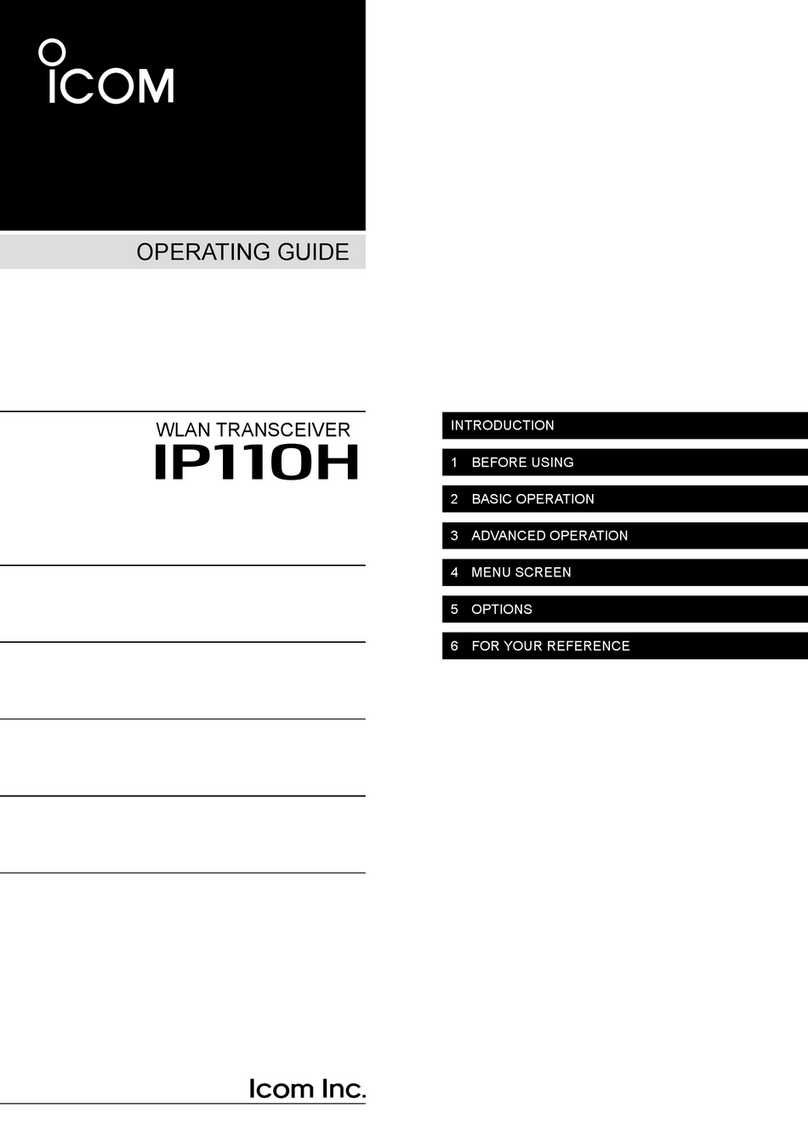
Icom
Icom IP110H User manual
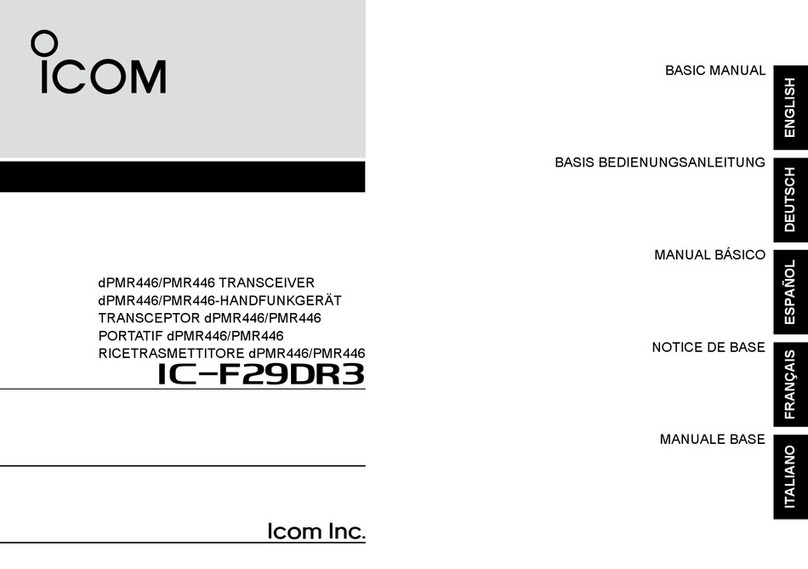
Icom
Icom IC-F29DR3 Installation guide
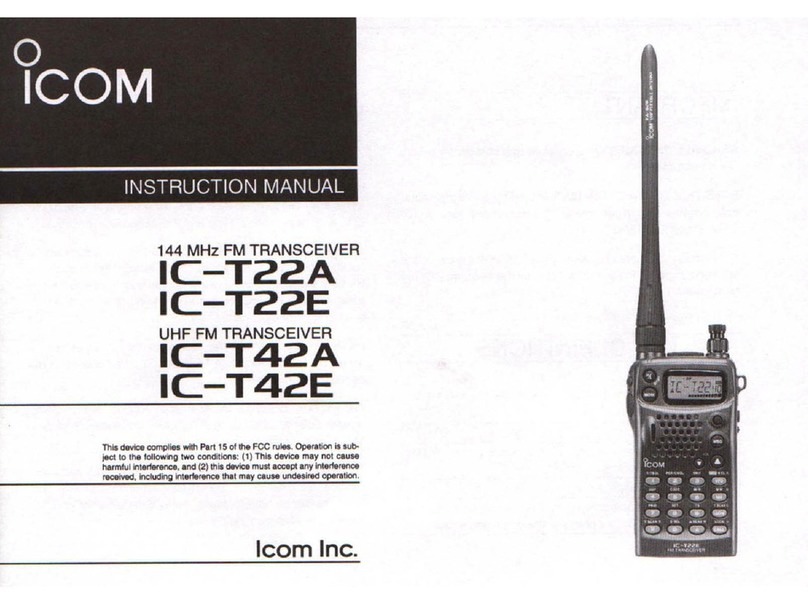
Icom
Icom IC-T22A User manual
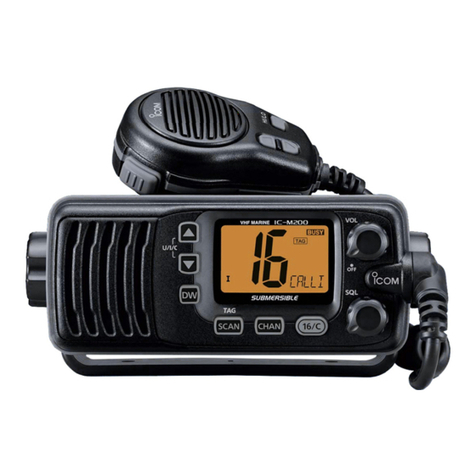
Icom
Icom IC-M200 User manual
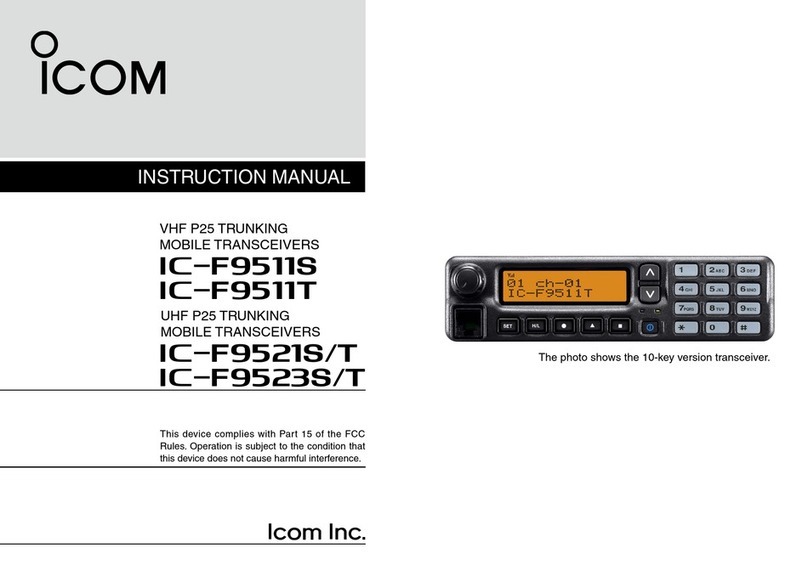
Icom
Icom IC-F9511S User manual

Icom
Icom IC-V85 User manual
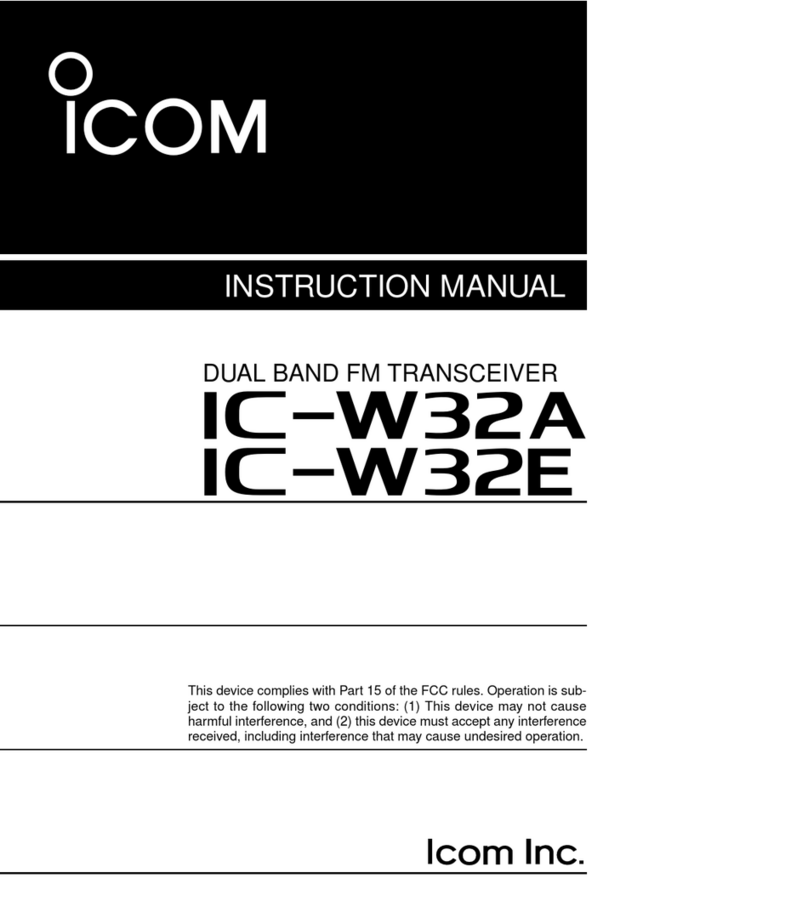
Icom
Icom IC-W32A User manual
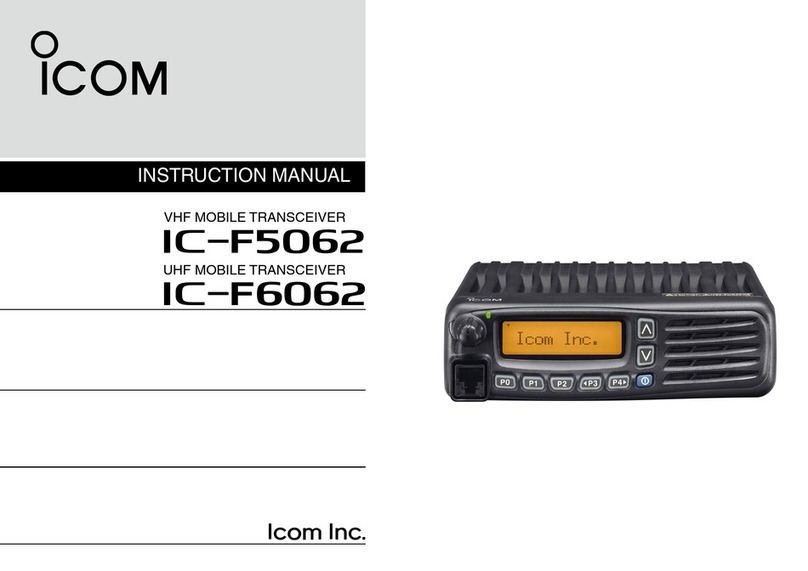
Icom
Icom IC-F5062 User manual
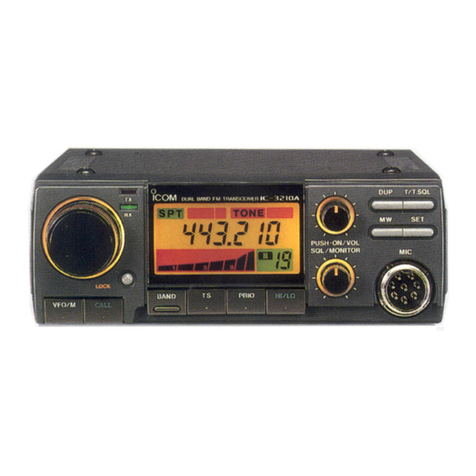
Icom
Icom IC-3210A User manual
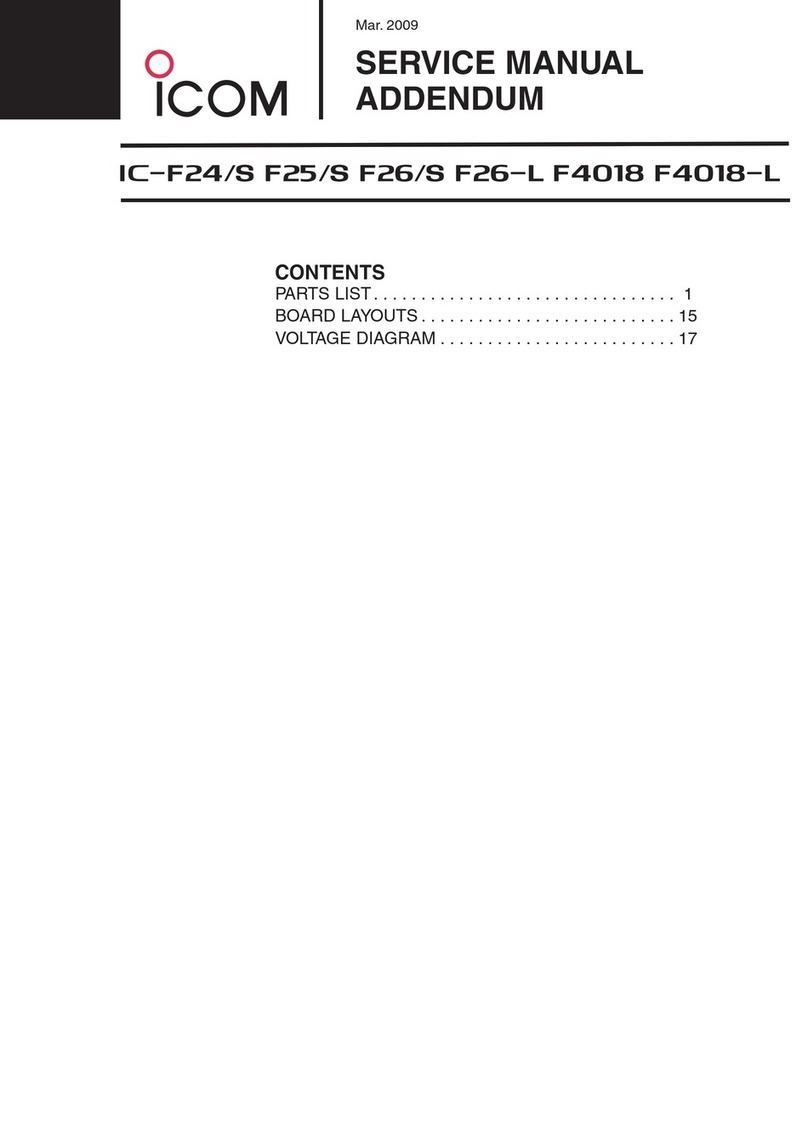
Icom
Icom IC-F24/S Installation and operating instructions
Popular Transceiver manuals by other brands
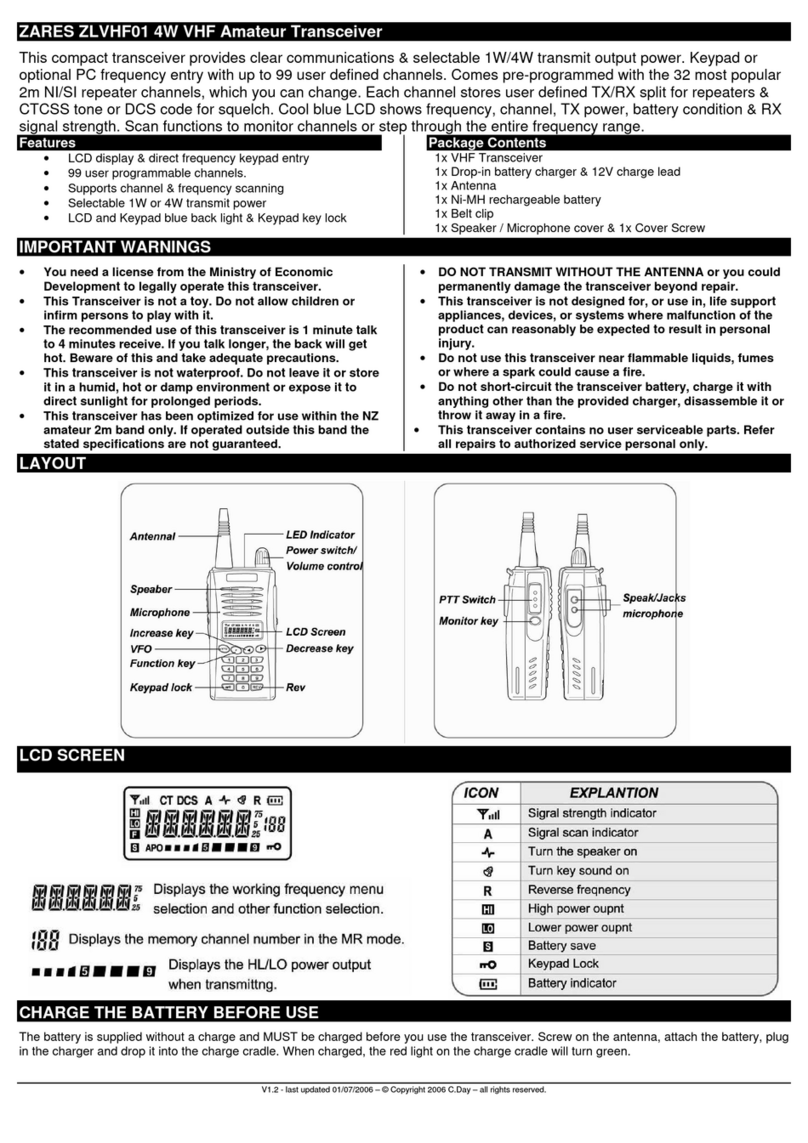
Zares
Zares ZLVHF01 quick guide

Vertex Standard
Vertex Standard VX-230 Series Service manual
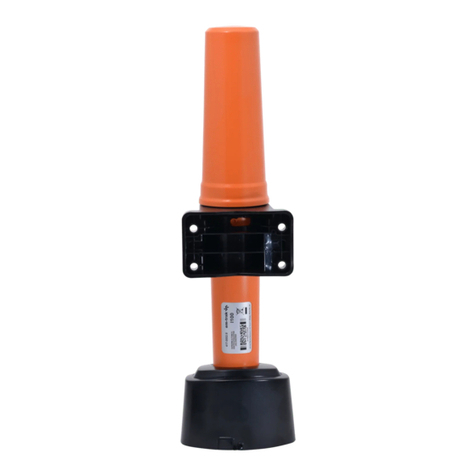
Em-Trak
Em-Trak I100 Product configuration manual

Skanti
Skanti TRP 9250 Technical manual
NXP Semiconductors
NXP Semiconductors freescale semiconductor MC13211 Reference manual

ELECRAFT
ELECRAFT K3 installation instructions
